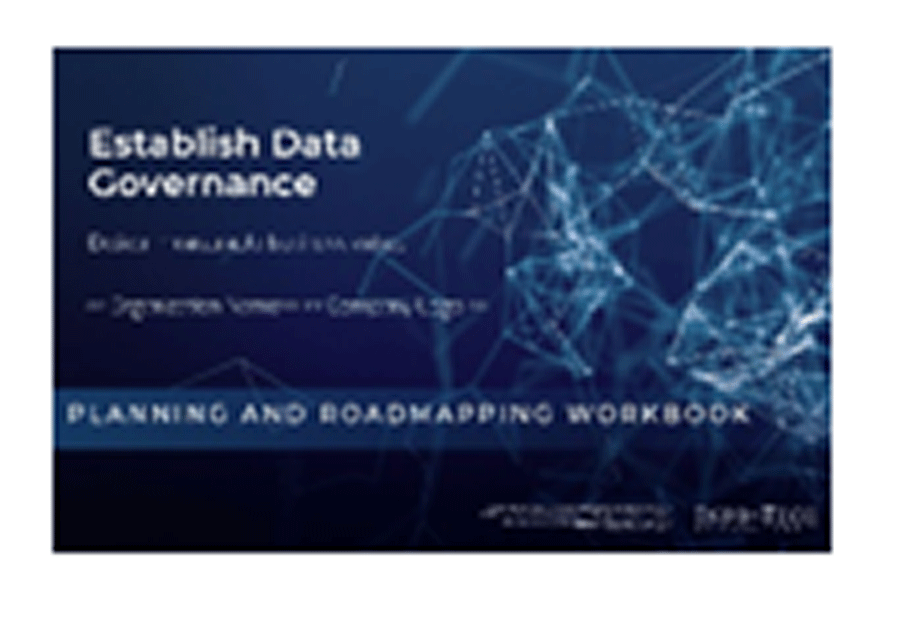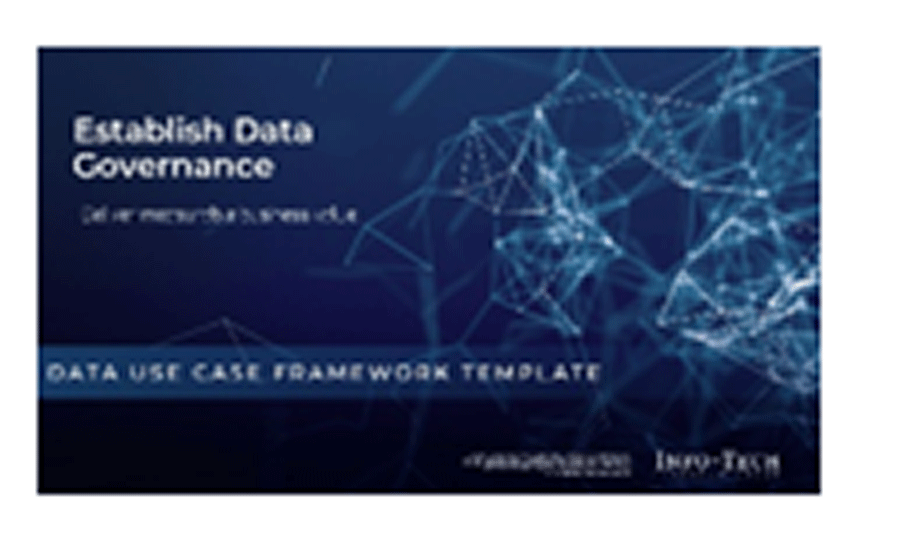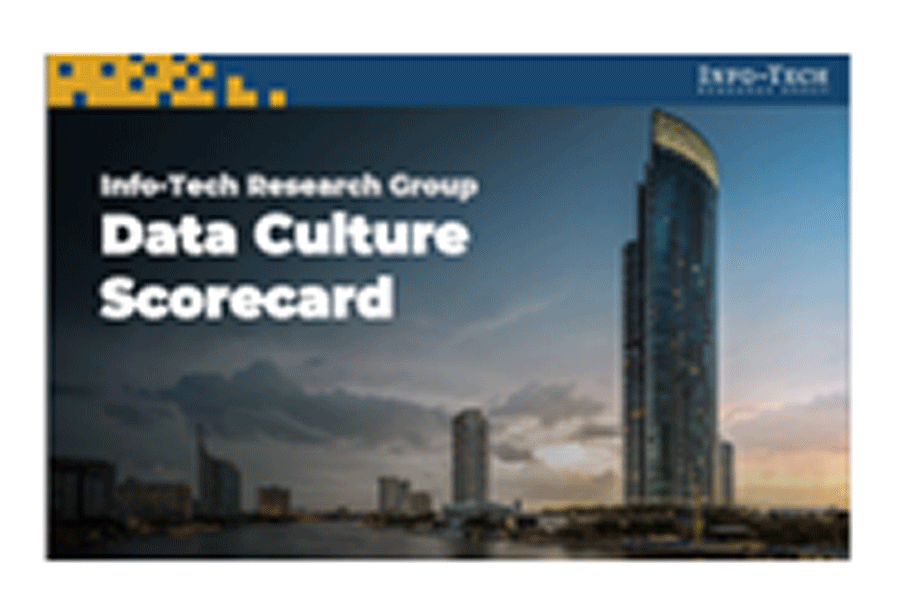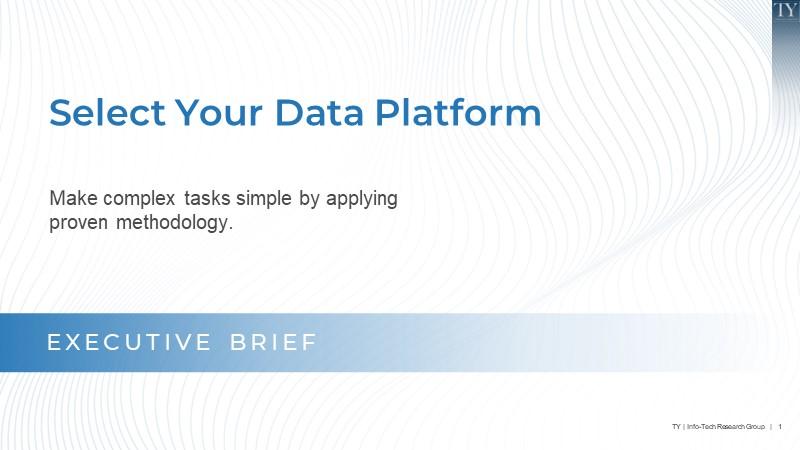
Establish Data Governance – APAC Edition
- Organisations are faced with challenges associated with changing data landscapes, evolving business models, industry disruptions, regulatory and compliance obligations, and changing and maturing user landscapes and demands for data.
- Although the need for a data governance program is often evident, organisations miss the mark when their data governance efforts are not directly aligned to delivering measurable business value by supporting key strategic initiatives, value streams, and their underlying business capabilities.
Our Advice
Critical Insight
- Your organisation’s value streams and the associated business capabilities require effectively governed data. Without this, you face the impact of elevated operational costs, missed opportunities, eroded stakeholder satisfaction, and exposure to increased business risk.
- Ensure your data governance program delivers measurable business value by aligning the associated data governance initiatives with the business architecture.
- Data governance must continuously align with the organisation’s enterprise governance function. It should not be perceived as an IT pet project, but rather as a business-driven initiative.
Impact and Result
Info-Tech’s approach to establishing and sustaining effective data governance is anchored in the strong alignment of organisational value streams and their business capabilities with key data governance dimensions and initiatives.
- Align with enterprise governance, business strategy and organizational value streams to ensure the program delivers measurable business value.
- Understand your current data governance capabilities and build out a future state that is right sized and relevant.
- Define data governance leadership, accountability, and responsibility, supported by an operating model that effectively manages change and communication and fosters a culture of data excellence.
Establish Data Governance – APAC Edition Research & Tools
Besides the small introduction, subscribers and consulting clients within this management domain have access to:
1. Data Governance Research – A step-by-step document to ensure that the people handling the data are involved in the decisions surrounding data usage, data quality, business processes, and change implementation.
Data governance is a strategic program that will help your organisation control data by managing the people, processes, and information technology needed to ensure that accurate and consistent data policies exist across varying lines of the business, enabling data-driven insight. This research will provide an overview of data governance and its importance to your organization, assist in making the case and securing buy-in for data governance, identify data governance best practices and the challenges associated with them, and provide guidance on how to implement data governance best practices for a successful launch.
- Establish Data Governance – Phases 1-3 – APAC
2. Data Governance Planning and Roadmapping Workbook – A structured tool to assist with establishing effective data governance practices.
This workbook will help your organisation understand the business and user context by leveraging your business capability map and value streams, developing data use cases using Info-Tech's framework for building data use cases, and gauging the current state of your organisation's data culture.
- Data Governance Planning and Roadmapping Workbook – APAC
3. Data Use Case Framework Template – An exemplar template to highlight and create relevant use cases around the organisation’s data-related problems and opportunities.
This business needs gathering activity will highlight and create relevant use cases around data-related problems or opportunities that are clear and contained and, if addressed, will deliver value to the organisation. This template provides a framework for data requirements and a mapping methodology for creating use cases.
- Data Use Case Framework Template – APAC
4. Data Governance Initiative Planning and Roadmap Tool – A visual roadmapping tool to assist with establishing effective data governance practices.
This tool will help your organisation plan the sequence of activities, capture start dates and expected completion dates, and create a roadmap that can be effectively communicated to the organisation.
- Data Governance Initiative Planning and Roadmap Tool – APAC
5. Business Data Catalogue – A comprehensive template to help you to document the key data assets that are to be governed based on in-depth business unit interviews, data risk/value assessments, and a data flow diagram for the organisation.
Use this template to document information about key data assets such as data definition, source system, possible values, data sensitivity, data steward, and usage of the data.
- Business Data Catalogue – APAC
6. Data Governance Program Charter Template – A program charter template to sell the importance of data governance to senior executives.
This template will help get the backing required to get a data governance project rolling. The program charter will help communicate the project purpose, define the scope, and identify the project team, roles, and responsibilities.
- Data Governance Program Charter Template – APAC
7. Data Policies – A set of policy templates to support the data governance framework for the organisation.
This set of policies supports the organisation's use and management of data to ensure that it efficiently and effectively serves the needs of the organisation.
- Data Governance Policy – APAC
- Data Classification Policy, Standard, and Procedure – APAC
- Data Quality Policy, Standard, and Procedure – APAC
- Data Management Definitions – APAC
- Metadata Management Policy, Standard, and Procedure – APAC
- Data Retention Policy and Procedure – APAC
Workshop: Establish Data Governance – APAC Edition
Workshops offer an easy way to accelerate your project. If you are unable to do the project yourself, and a Guided Implementation isn't enough, we offer low-cost delivery of our project workshops. We take you through every phase of your project and ensure that you have a roadmap in place to complete your project successfully.
1 Establish Business Context and Value
The Purpose
Identify key business data assets that need to be governed.
Create a unifying vision for the data governance program.
Key Benefits Achieved
Understand the value of data governance and how it can help the organisation better leverage its data.
Gain knowledge of how data governance can benefit both IT and the business.
Activities
1.1 Establish business context, value, and scope of data governance at the organisation.
1.2 Introduction to Info-Tech’s data governance framework.
1.3 Discuss vision and mission for data governance.
1.4 Understand your business architecture, including your business capability map and value streams.
1.5 Build use cases aligned to core business capabilities.
Outputs
Sample use cases (tied to the business capability map) and a repeatable use case framework
Vision and mission for data governance
2 Understand Current Data Governance Capabilities and Plot Target-State Levels
The Purpose
Assess which data contains value and/or risk and determine metrics that will determine how valuable the data is to the organisation.
Assess where the organisation currently stands in data governance initiatives.
Determine gaps between the current and future states of the data governance program.
Key Benefits Achieved
Gain a holistic understanding of organisational data and how it flows through business units and systems.
Identify which data should fall under the governance umbrella.
Determine a practical starting point for the program.
Activities
2.1 Understand your current data governance capabilities and maturity.
2.2 Set target-state data governance capabilities.
Outputs
Current state of data governance maturity
Definition of target state
3 Build Data Domain to Data Governance Role Mapping
The Purpose
Determine strategic initiatives and create a roadmap outlining key steps required to get the organisation to start enabling data-driven insights.
Determine timing of the initiatives.
Key Benefits Achieved
Establish clear direction for the data governance program.
Step-by-step outline of how to create effective data governance, with true business-IT collaboration.
Activities
3.1 Evaluate and prioritise performance gaps.
3.2 Develop and consolidate data governance target-state initiatives.
3.3 Define the role of data governance: data domain to data governance role mapping.
Outputs
Target-state data governance initiatives
Data domain to data governance role mapping
4 Formulate a Plan to Get to Your Target State
The Purpose
Consolidate the roadmap and other strategies to determine the plan of action from day one.
Create the required policies, procedures, and positions for data governance to be sustainable and effective.
Key Benefits Achieved
Prioritised initiatives with dependencies mapped out.
A clearly communicated plan for data governance that will have full business backing.
Activities
4.1 Identify and prioritise next steps.
4.2 Define roles and responsibilities and complete a high-level RACI.
4.3 Wrap-up and discuss next steps and post-workshop support.
Outputs
Initialised roadmap
Initialised RACI
Further reading
Establish Data Governance
Deliver measurable business value.
Analyst Perspective
Establish a data governance program that brings value to your organisation.

Data governance does not sit as an island on its own in the organisation – it must align with and be driven by your enterprise governance. As you build out data governance in your organisation, it's important to keep in mind that this program is meant to be an enabling framework of oversight and accountabilities for managing, handling, and protecting your company's data assets. It should never be perceived as bureaucratic or inhibiting to your data users. It should deliver agreed-upon models that are conducive to your organisation's operating culture, offering clarity on who can do what with the data and via what means. Data governance is the key enabler for bringing high-quality, trusted, secure, and discoverable data to the right users across your organisation. Promote and drive the responsible and ethical use of data while helping to build and foster an organisational culture of data excellence.
Crystal Singh
Director, Research & Advisory, Data & Analytics Practice
Info-Tech Research Group
Executive Summary
Your Challenge
The amount of data within organisations is growing at an exponential rate, creating a need to adopt a formal approach to governing data. However, many organisations remain uninformed on how to effectively govern their data. Comprehensive data governance should define leadership, accountability, and responsibility related to data use and handling and be supported by a well-oiled operating model and relevant policies and procedures. This will help ensure the right data gets to the right people at the right time, using the right mechanisms.
Common Obstacles
Organisations are faced with challenges associated with changing data landscapes, evolving business models, industry disruptions, regulatory and compliance obligations, and changing and maturing user landscape and demand for data. Although the need for a data governance program is often evident, organisations miss the mark when their data governance efforts are not directly aligned to delivering measurable business value. Initiatives should support key strategic initiatives, as well as value streams and their underlying business capabilities.
Info-Tech's Approach
Info-Tech's approach to establishing and sustaining effective data governance is anchored in the strong alignment of organisational value streams and their business capabilities with key data governance dimensions and initiatives. Organisations should:
- Align their data governance with enterprise governance, business strategy and value streams to ensure the program delivers measurable business value.
- Understand their current data governance capabilities so as to build out a future state that is right-sized and relevant.
- Define data leadership, accountability, and responsibility. Support these with an operating model that effectively manages change and communication and fosters a culture of data excellence.
Info-Tech Insight
Your organisation's value streams and the associated business capabilities require effectively governed data. Without this, you face elevated operating costs, missed opportunities, eroded stakeholder satisfaction, and increased business risk.
Your challenge
This research is designed to help organisations build and sustain an effective data governance program.
- Your organisation has recognised the need to treat data as a corporate asset for generating business value and/or managing and mitigating risk.
- This has brought data governance to the forefront and highlighted the need to build a performance-driven enterprise program for delivering quality, trusted, and readily consumable data to users.
- An effective data governance program is one that defines leadership, accountability. and responsibility related to data use and handling. It's supported by a well-oiled operating model and relevant policies and procedures, all of which help build and foster a culture of data excellence where the right users get access to the right data at the right time via the right mechanisms.
As you embark on establishing data governance in your organisation, it's vital to ensure from the get-go that you define the drivers and business context for the program. Data governance should never be attempted without direction on how the program will yield measurable business value.
'Data processing and cleanup can consume more than half of an analytics team's time, including that of highly paid data scientists, which limits scalability and frustrates employees.' – Petzold, et al., 2020
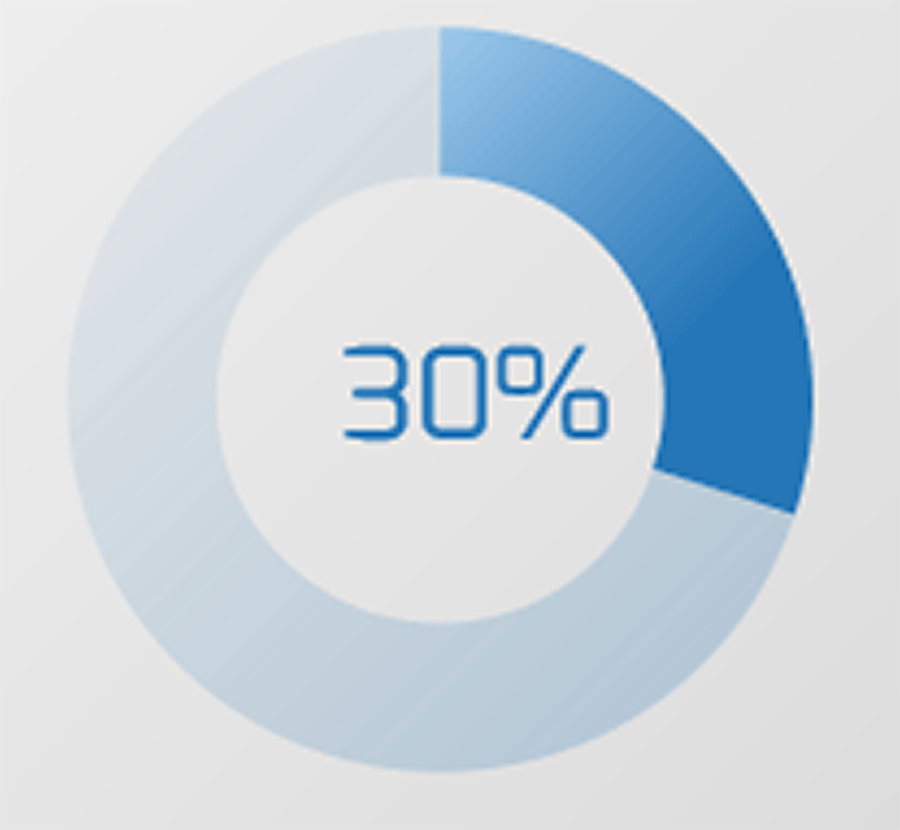
'The productivity of employees across the organisation can suffer.' – Petzold, et al., 2020
Respondents to McKinsey's 2019 Global Data Transformation Survey reported that an average of 30% of their total enterprise time was spent on non-value-added tasks because of poor data quality and availability. – Petzold, et al., 2020
Common obstacles
Some of the barriers that make data governance difficult to address for many organisations include:
- Gaps in communicating the strategic value of data and data governance to the organisation. This is vital for securing senior leadership buy-in and support, which, in turn, is crucial for sustained success of the data governance program.
- Misinterpretation or a lack of understanding about data governance, including what it means for the organisation and the individual data user.
- A perception that data governance is inhibiting or an added layer of bureaucracy or complication rather than an enabling and empowering framework for stakeholders in their use and handling of data.
- Embarking on data governance without firmly substantiating and understanding the organisational drivers for doing so. How is data governance going to support the organisation's value streams and their various business capabilities?
- Neglecting to define and measure success and performance. Just as in any other enterprise initiative, you have to be able to demonstrate an ROI for time, resources and funding. These metrics must demonstrate the measurable business value that data governance brings to the organisation.
- Failure to align data governance with enterprise governance.
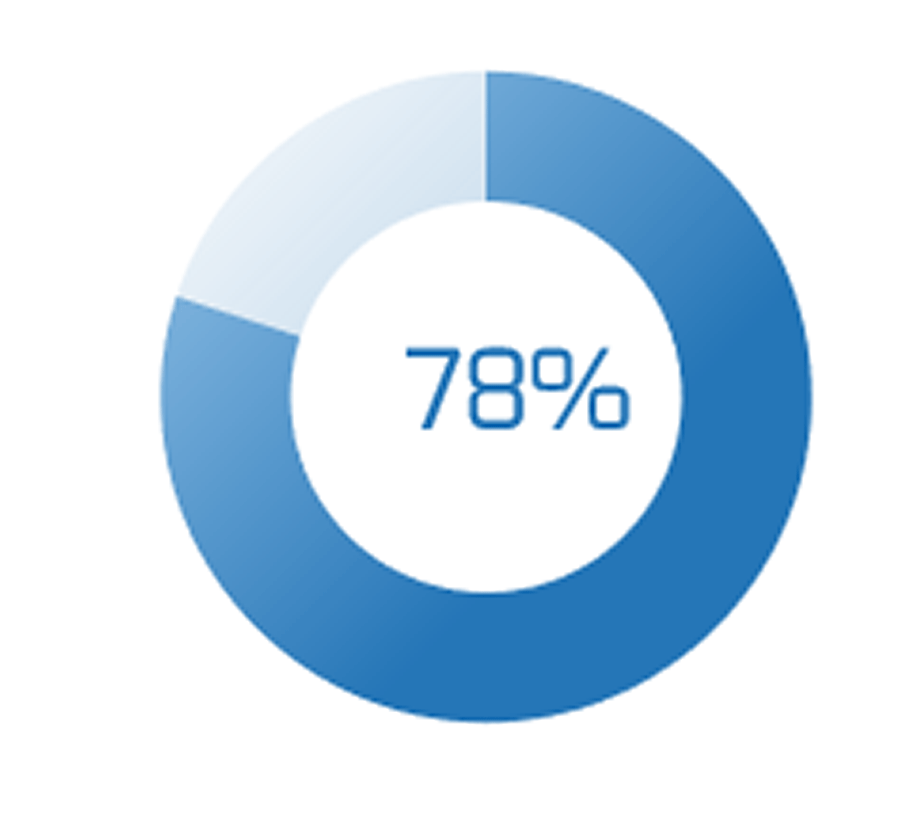
78% of companies (and 92% of top-tier companies) have a corporate initiative to become more data-driven. – Alation, 2020.
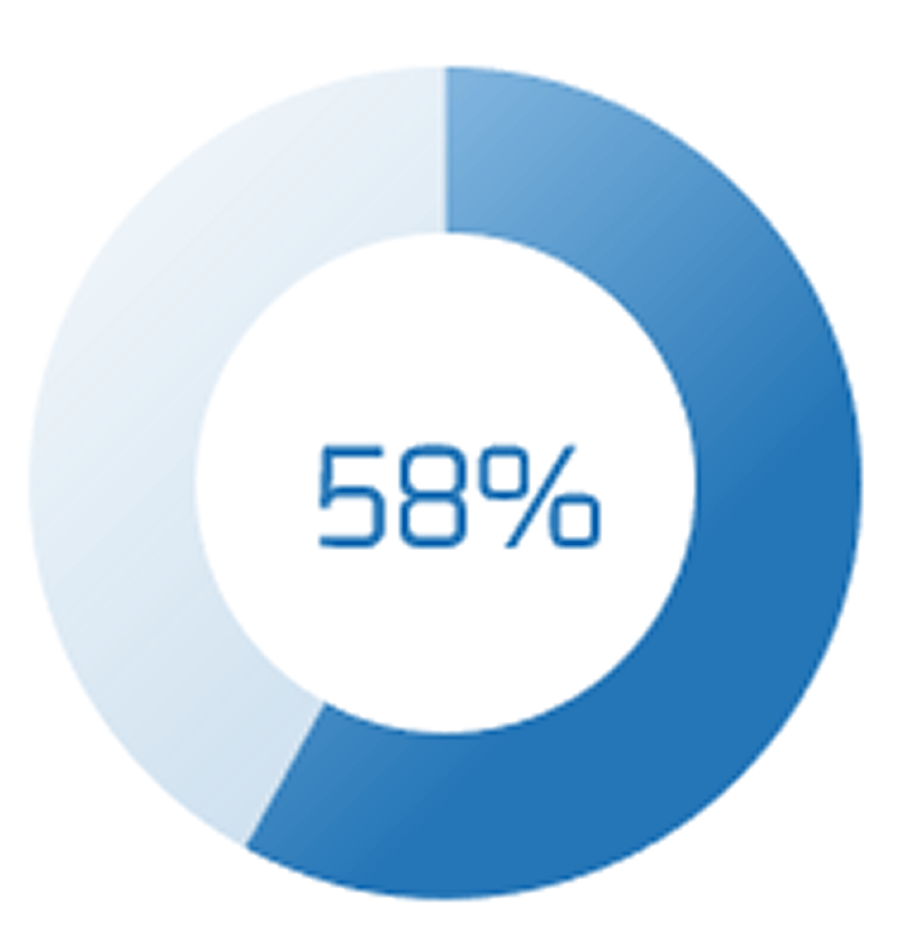
But despite these ambitions, there appears to be a 'data culture disconnect' – 58% of leaders overestimate the current data culture of their enterprises, giving a grade higher than the one produced by the study. – Fregoni, 2020.
The strategic value of data
Power intelligent and transformative organisational performance through leveraging data.
Respond to industry disruptors
Optimise the way you serve your stakeholders and customers
Develop products and services to meet ever-evolving needs
Manage operations and mitigate risk
Harness the value of your data
The journey to being data-driven
The journey to declaring that you are a data-driven organisation requires a pit stop at data enablement.
The Data Economy
Data Disengaged
You have a low appetite for data and rarely use data for decision making.
Data Enabled
Technology, data architecture, and people and processes are optimised and supported by data governance.
Data Driven
You are differentiating and competing on data and analytics; described as a 'data first' organisation. You're collaborating through data. Data is an asset.
Data governance is essential for any organisation that makes decisions about how it uses its data.
Data governance is an enabling framework of decision rights, responsibilities, and accountabilities for data assets across the enterprise.
Data governance is:
- Executed according to agreed-upon models that describe who can take what actions with what information, when, and using what methods (Olavsrud, 2021).
- True business-IT collaboration that will lead to increased consistency and confidence in data to support decision making. This, in turn, helps fuel innovation and growth.
If done correctly, data governance is not:
- An annoying, finger-waving roadblock in the way of getting things done.
- Meant to solve all data-related business or IT problems in an organisation.
- An inhibitor or impediment to using and sharing data.
Info-Tech's Data Governance Framework
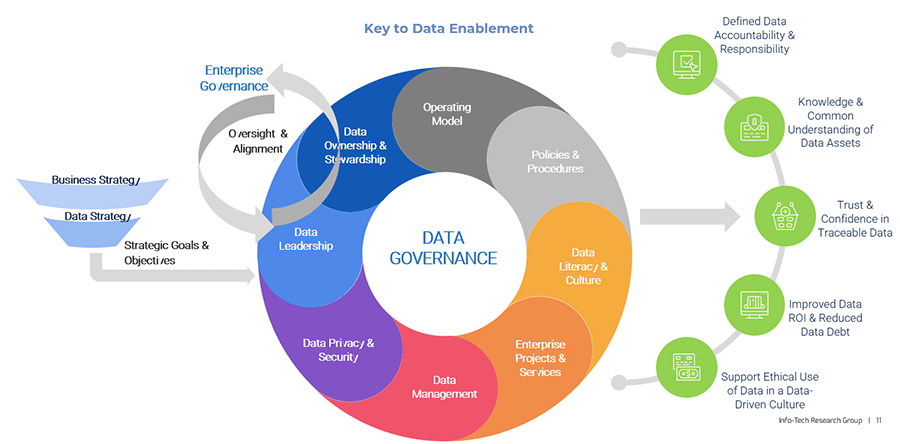
Create impactful data governance by embedding it within enterprise governance
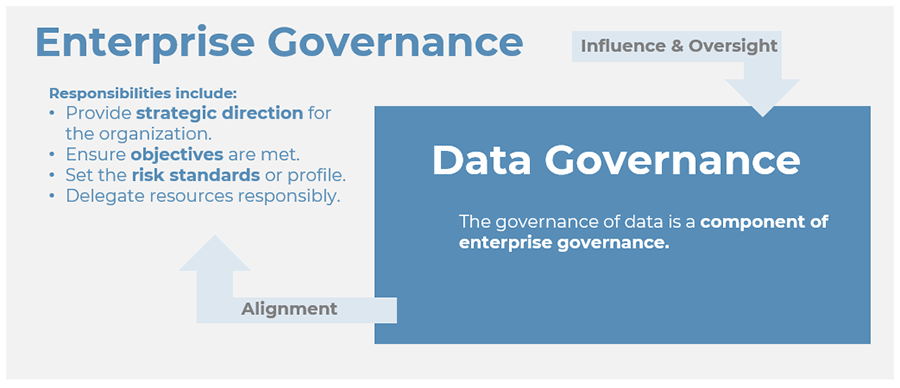
Organisational drivers for data governance
Data governance personas:
Conformance: Establishing data governance to meet regulations and compliance requirements.
Performance: Establishing data governance to fuel data-driven decision making for driving business value and managing and mitigating business risk.
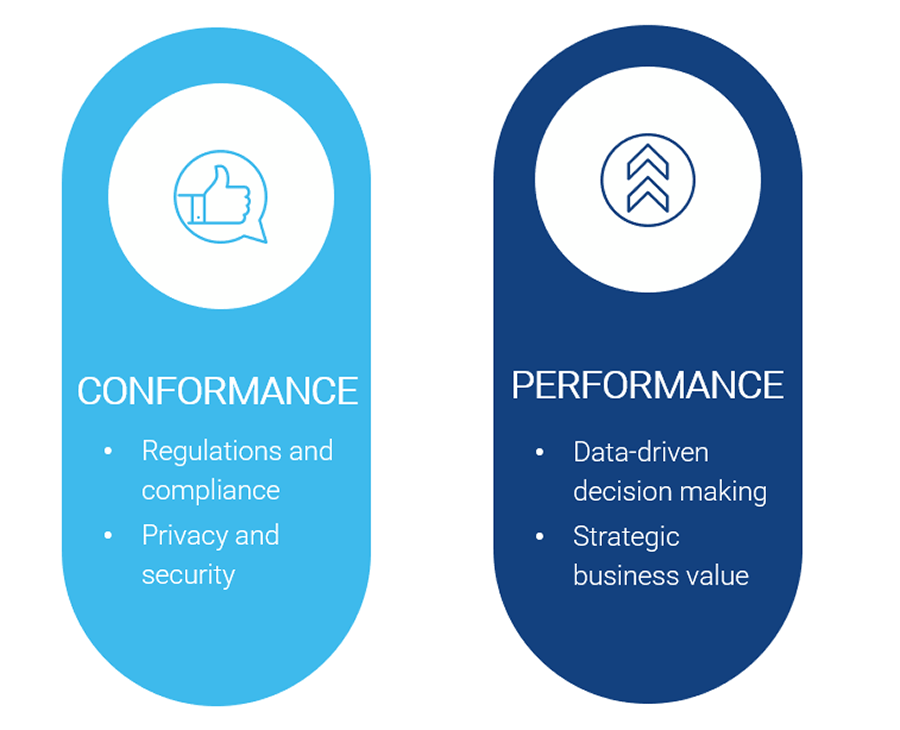
Data Governance is not a one-person show
- Data governance needs a leader and a home. Define who is going to be leading, driving, and steering data governance in your organisation.
- Senior executive leaders play a crucial role in championing and bringing visibility to the value of data and data governance. This is vital for building and fostering a culture of data excellence.
- Effective data governance comes with business and IT alignment, collaboration, and formally defined roles around data leadership, ownership, and stewardship.

Traditional data governance organisational structure
A traditional structure includes committees and roles that span across strategic, tactical, and operational duties. There is no one-size-fits-all data governance structure. However, most organisations follow a similar pattern when establishing committees, councils, and cross-functional groups. Most organisations strive to identify roles and responsibilities at a strategic and operational level. Several factors will influence the structure of the program, such as the focus of the data governance project and the maturity and size of the organisation.

A healthy data culture is key to amplifying the power of your data.
'Albert Einstein is said to have remarked, "The world cannot be changed without changing our thinking." What is clear is that the greatest barrier to data success today is business culture, not lagging technology.' – Randy Bean, 2020
What does it look like?
- Everybody knows the data.
- Everybody trusts the data.
- Everybody talks about the data.
'It is not enough for companies to embrace modern data architectures, agile methodologies, and integrated business-data teams, or to establish centres of excellence to accelerate data initiatives, when only about 1 in 4 executives reported that their organisation has successfully forged a data culture.'– Randy Bean, 2020
Data literacy is an essential part of a data-driven culture
- In a data-driven culture, decisions are made based on data evidence, not on gut instinct.
- Data often has untapped potential. A data-driven culture builds tools and skills, builds users' trust in the condition and sources of data, and raises the data skills and understanding among their people on the front lines.
- Building a data culture takes an ongoing investment of time, effort, and money. This investment will not achieve the transformation you want without data literacy at the grassroots level.
Data-driven culture = 'data matters to our company'
Despite investments in data initiative, organisations are carrying high levels of data debt
Data debt is 'the accumulated cost that is associated with the sub-optimal governance of data assets in an enterprise, like technical debt.'
Data debt is a problem for 78% of organisations.
40% of organisations say individuals within the business do not trust data insights.
66% of organisations say a backlog of data debt is impacting new data management initiatives.
33% of organisations are not able to get value from a new system or technology investment.
30% of organisations are unable to become data-driven.
Source: Experian, 2020
Absent or sub-optimal data governance leads to data debt
Only 3% of companies' data meets basic quality standards. (Source: Nagle, et al., 2017)
Organisations suspect 28% of their customer and prospect data is inaccurate in some way. (Source: Experian, 2020)
Only 51% of organisations consider the current state of their CRM or ERP data to be clean, allowing them to fully leverage it. (Source: Experian, 2020)
35% of organisations say they're not able to see a ROI for data management initiatives. (Source: Experian, 2020)
Embrace the technology
Make the available data governance tools and technology work for you:
- Data catalogue
- Business data glossary
- Data lineage
- Metadata management
While data governance tools and technologies are no panacea, leverage their automated and AI-enabled capabilities to augment your data governance program.
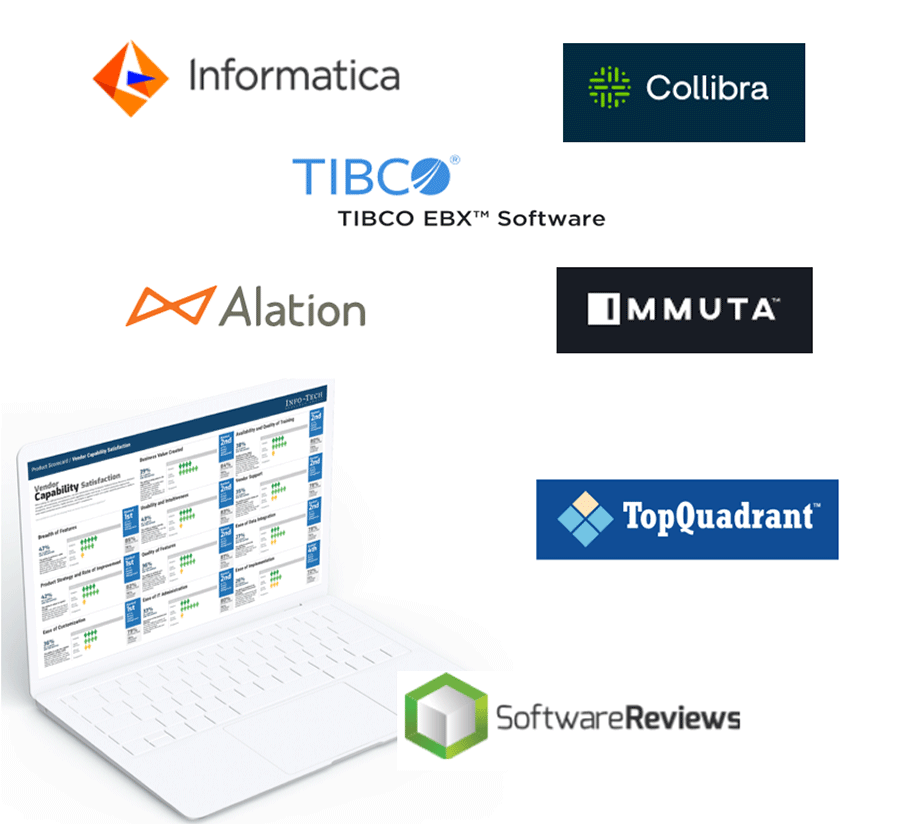
Measure success to demonstrate tangible business value
Put data governance into the context of the business:
- Tie the value of data governance and its initiatives back to the business capabilities that are enabled.
- Leverage the KPIs of those business capabilities to demonstrate tangible and measurable value. Use terms and language that will resonate with senior leadership.
Don't let measurement be an afterthought:
Start substantiating early on how you are going to measure success as your data governance program evolves.
Build a right-sized roadmap
Formulate an actionable roadmap that is right-sized to deliver value in your organisation.
Key considerations:
- When building your data governance roadmap, ensure you do so through an enterprise lens. Be cognizant of other initiatives that might be coming down the pipeline that may require you to align your data governance milestones accordingly.
- Apart from doing your planning with consideration for other big projects or launches that might be in-flight and require the time and attention of your data governance partners, also be mindful of the more routine yet still demanding initiatives.
- When doing your roadmapping, consider factors like the organisation's fiscal cycle, typical or potential year-end demands, and monthly/quarterly reporting periods and audits. Initiatives such as these are likely to monopolise the time and focus of personnel key to delivering on your data governance milestones.
Sample milestones:
Data Governance Leadership & Org Structure Definition
Define the home for data governance and other key roles around ownership and stewardship, as approved by senior leadership.
Data Governance Charter and Policies
Create a charter for your program and build/refresh associated policies.
Data Culture Diagnostic
Understand the organisation's current data culture, perception of data, value of data, and knowledge gaps.
Use Case Build and Prioritisation
Build a use case that is tied to business capabilities. Prioritise accordingly.
Business Data Glossary
Build and/or refresh the business' glossary for addressing data definitions and standardisation issues.
Tools & Technology
Explore the tools and technology offering in the data governance space that would serve as an enabler to the program. (e.g. RFI, RFP).
Key takeaways for effective business-driven data governance
Data governance leadership and sponsorship is key.
Ensure strategic business alignment.
Build and foster a culture of data excellence.
Evolve along the data journey.
Make data governance an enabler, not a hindrance.
Insight summary
Overarching insight
Your organisation's value streams and the associated business capabilities require effectively governed data. Without this, you face the impact of elevated operational costs, missed opportunities, eroded stakeholder satisfaction, and exposure to increased business risk.
Insight 1
Data governance should not sit as an island in your organisation. It must continuously align with the organisation's enterprise governance function. It shouldn't be perceived as a pet project of IT, but rather as an enterprise-wide, business-driven initiative.
Insight 2
Ensure your data governance program delivers measurable business value by aligning the associated data governance initiatives with the business architecture. Leverage the measures of success or KPIs of the underlying business capabilities to demonstrate the value data governance has yielded for the organisation.
Insight 3
Data governance remains the foundation of all forms of reporting and analytics. Advanced capabilities such as AI and machine learning require effectively governed data to fuel their success.
Tactical insight
Tailor your data literacy program to meet your organisation's needs, filling your range of knowledge gaps and catering to your different levels of stakeholders. When it comes to rolling out a data literacy program, there is no one-size-fits-all solution. Your data literacy program is intended to fill the knowledge gaps about data, as they exist in your organisation. It should be targeted across the board – from your executive leadership and management through to the subject matter experts across different lines of the business in your organisation.
Info-Tech's methodology for establishing data governance
| 1. Build Business and User Context | 2. Understand Your Current Data Governance Capabilities | 3. Build a Target State Roadmap and Plan | |
|---|---|---|---|
| Phase Steps |
|
|
|
| Phase Outcomes |
|
|
|
Blueprint deliverables
Each step of this blueprint is accompanied by supporting deliverables to help you accomplish your goals:
Data Governance Planning and Roadmapping Workbook
Use the Data Governance Planning and Roadmapping Workbook as you plan, build, roll out, and scale data governance in your organisation.
Data Use Case Framework Template
This template takes you through a business needs gathering activity to highlight and create relevant use cases around the organisation's data-related problems and opportunities.
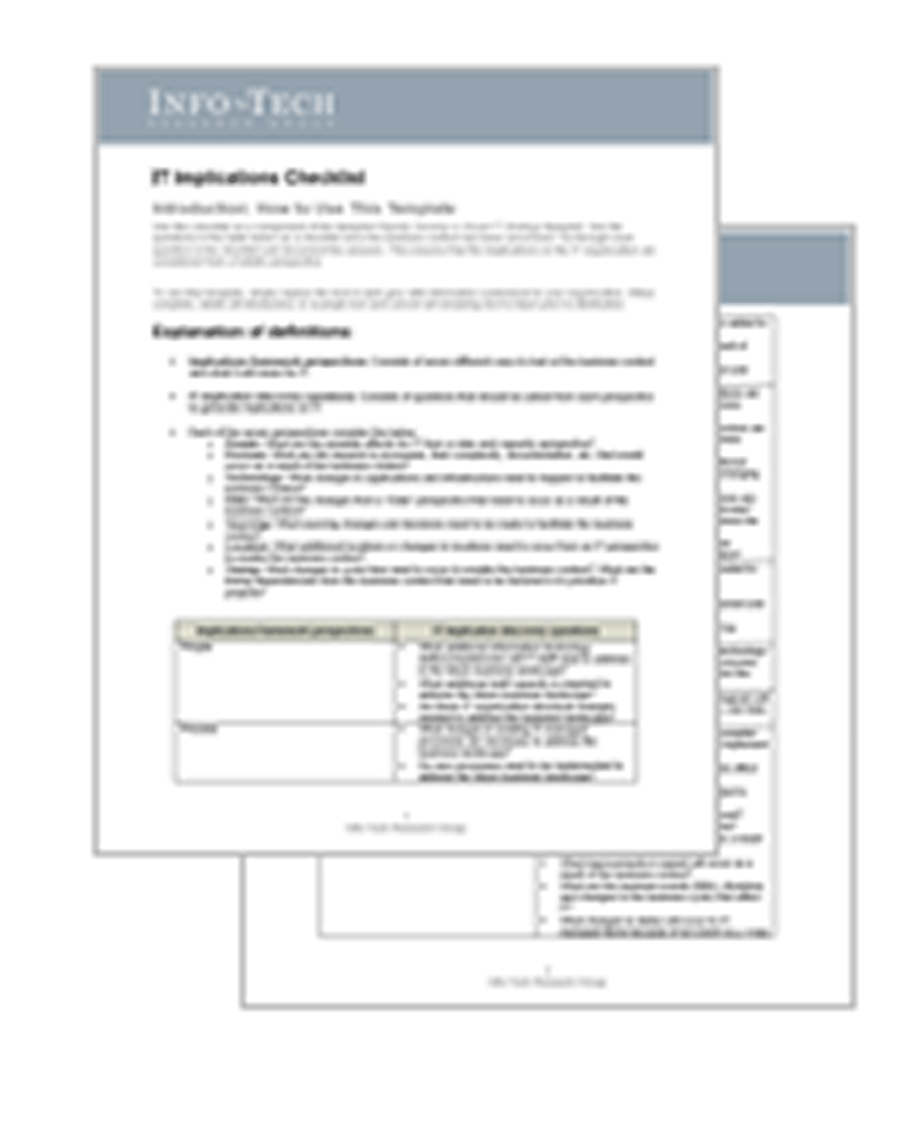
Use this template to document the key data assets that are to be governed and create a data flow diagram for your organisation.
Data Culture Diagnostic and Scorecard
Leverage Info-Tech's Data Culture Diagnostic to understand how your organisation scores across 10 areas relating to data culture.
Key deliverable:
Blueprint deliverables
Each step of this blueprint is accompanied by supporting deliverables to help you accomplish your goals:
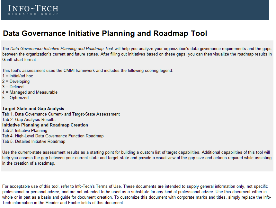
Data Governance Initiative Planning and Roadmap Tool
Leverage this tool to assess your current data governance capabilities and plot your target state accordingly.
This tool will help you plan the sequence of activities, capture start dates and expected completion dates, and create a roadmap that can be effectively communicated to the organisation.

Data Governance Program Charter Template
This template will help get the backing required to get a data governance project rolling. The program charter will help communicate the project purpose, define the scope, and identify the project team, roles, and responsibilities.
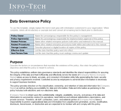
This policy establishes uniformed data governance standards and identifies the shared responsibilities for assuring the integrity of the data and that it efficiently and effectively serves the needs of your organisation
Other Deliverables:
- Data Governance Initiative Planning and Roadmap Tool
- Data Governance Program Charter Template
- Data Governance Policy
Blueprint benefits
Defined data accountability & responsibility
Shared knowledge & common understanding of data assets
Elevated trust & confidence in traceable data
Improved data ROI & reduced data debt
Support for ethical use and handling of data in a culture of excellence
Measure the value of this blueprint
Leverage this blueprint's approach to ensure your data governance initiatives align and support your key value streams and their business capabilities.
- Aligning your data governance program and its initiatives to your organisation's business capabilities is vital for tracing and demonstrating measurable business value for the program.
- This alignment of data governance with value streams and business capabilities enables you to use business-defined KPIs and demonstrate tangible value.
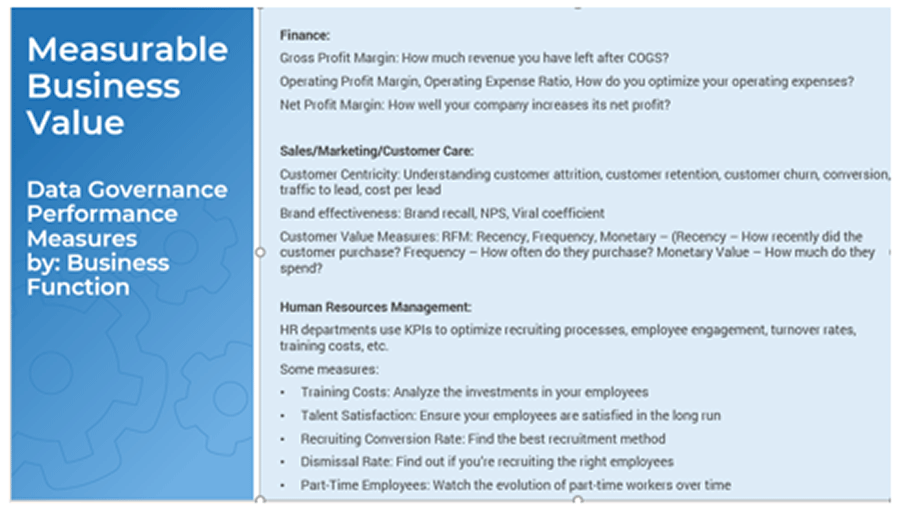
In phases 1 and 2 of this blueprint, we will help you establish the business context, define your business drivers and KPIs, and understand your current data governance capabilities and strengths.
In phase 3, we will help you develop a plan and a roadmap for addressing any gaps and improving the relevant data governance capabilities so that data is well positioned to deliver on those defined business metrics.
Info-Tech offers various levels of support to best suit your needs
DIY Toolkit
'Our team, has already made this critical project a priority, and we have the time and capability, but some guidance along the way would be helpful.'
Guided Implementation
'Our team knows that we need to fix a process, but we need assistance to determine where to focus. Some check-ins along the way would help keeps us on track.'
Workshop
'We need to hit the ground running and get this project kicked off immediately. Our team has the ability to take this over once we get a framework and strategy in place.'
Consulting
'Our team does not have the time or the knowledge to take this project on. We need assistance through the entirety of this project.'
Diagnostics and consistent frameworks are used throughout all four options.
Establish Data Governance project overview
Contact your account representative for more information. workshops@infotech.com 1-888-670-8889
| 1. Build Business and User context | 2. Understand Your Current Data Governance Capabilities | 3. Build a Target State Roadmap and Plan | |
|---|---|---|---|
| Best-Practice Toolkit |
|
|
|
| Guided Implementation |
|
|
|
| Phase Outcomes |
|
|
|
Guided Implementation
What does a typical GI on this topic look like?
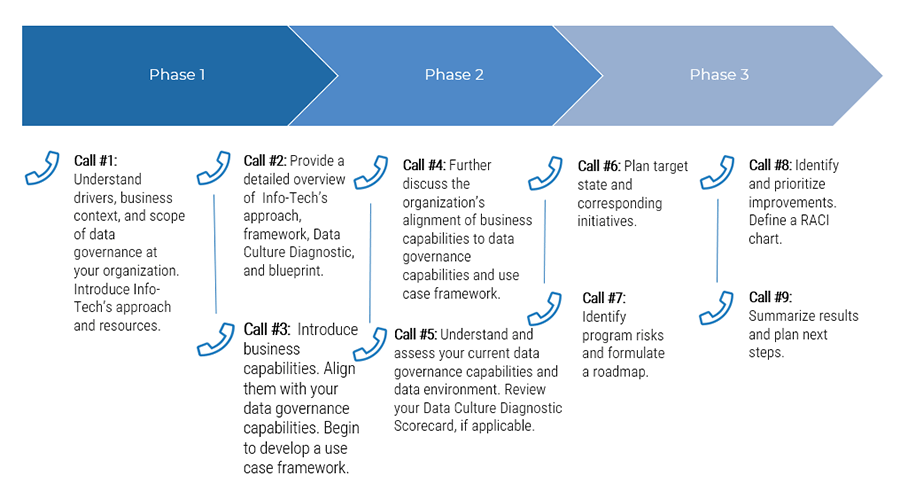
A Guided Implementation (GI) is a series of calls with an Info-Tech analyst to help implement our best practices in your organisation. A typical GI is between 8 to 12 calls over the course of 4 to 6 months.
Workshop overview
Contact your account representative for more information. workshops@infotech.com 1-888-670-8889
| Day 1 | Day 2 | Day 3 | Day 4 | |
|---|---|---|---|---|
| Establish Business Context and Value | Understand Current Data Governance Capabilities and Plot Target-State Levels | Build Data Domain to Data Governance Role Mapping | Formulate a Plan to Get to Your Target State | |
| Activities |
|
|
|
|
| Deliverables |
|
|
|
|
Phase 1
Build Business and User Context
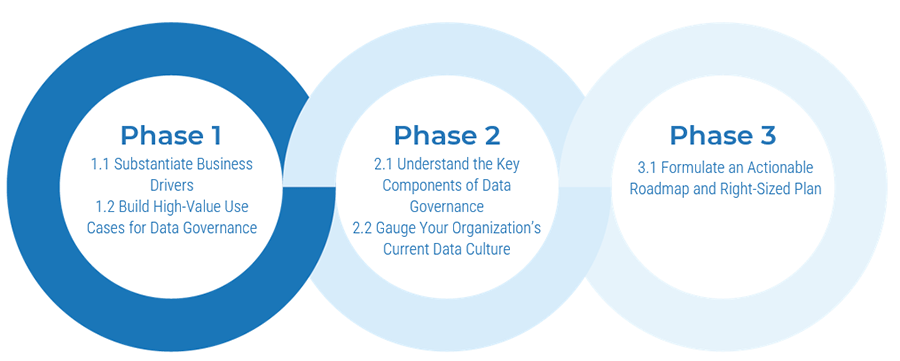
'When business users are invited to participate in the conversation around data with data users and IT, it adds a fundamental dimension — business context. Without a real understanding of how data ties back to the business, the value of analysis and insights can get lost.' – Jason Lim, Alation
This phase will guide you through the following activities:
- Identify Your Business Capabilities
- Define your Organisation's Key Business Capabilities
- Develop a Strategy Map that Aligns Business Capabilities to Your Strategic Focus
This phase involves the following participants:
- Data Governance Leader/Data Leader (CDO)
- Senior Business Leaders
- Business SMEs
- Data Leadership, Data Owners, Data Stewards and Custodians
Step 1.1
Substantiate Business Drivers
Activities
1.1.1 Identify Your Business Capabilities
1.1.2 Categorise Your Organisation's Key Business Capabilities
1.1.3 Develop a Strategy Map Tied to Data Governance
This step will guide you through the following activities:
- Leverage your organisation's existing business capability map or initiate the formulation of a business capability map, guided by Info-Tech's approach
- Determine which business capabilities are considered high priority by your organisation
- Map your organisation's strategic objectives to value streams and capabilities to communicate how objectives are realised with the support of data
Outcomes of this step
- A foundation for data governance initiative planning that's aligned with the organisation's business architecture: value streams, business capability map, and strategy map
Info-Tech Insight
Gaining a sound understanding of your business architecture (value streams and business capabilities) is a critical foundation for establishing and sustaining a data governance program that delivers measurable business value.
1.1.1 Identify Your Business Capabilities
Confirm your organisation's existing business capability map or initiate the formulation of a business capability map:
- If you have an existing business capability map, meet with the relevant business owners/stakeholders to confirm that the content is accurate and up to date. Confirm the value streams (how your organisation creates and captures value) and their business capabilities are reflective of the organisation's current business environment.
- If you do not have an existing business capability map, follow this activity to initiate the formulation of a map (value streams and related business capabilities):
- Define the organisation's value streams. Meet with senior leadership and other key business stakeholders to define how your organisation creates and captures value.
- Define the relevant business capabilities. Meet with senior leadership and other key business stakeholders to define the business capabilities.
Note: A business capability defines what a business does to enable value creation. Business capabilities are business terms defined using descriptive nouns such as 'Marketing' or 'Research and Development.' They represent stable business functions, are unique and independent of each other, and typically will have a defined business outcome.
Input
- List of confirmed value streams and their related business capabilities
Output
- Business capability map with value streams for your organisation
Materials
- Your existing business capability map or the template provided in the Data Governance Planning and Roadmapping Workbook accompanying this blueprint
Participants
- Key business stakeholders
- Data stewards
- Data custodians
- Data Governance Working Group
For more information, refer to Info-Tech's Document Your Business Architecture.
Define or validate the organisation's value streams
Value streams connect business goals to the organisation's value realisation activities. These value realisation activities, in turn, depend on data.
If the organisation does not have a business architecture function to conduct and guide Activity 1.1.1, you can leverage the following approach:
- Meet with key stakeholders regarding this topic, then discuss and document your findings.
- When trying to identify the right stakeholders, consider: Who are the decision makers and key influencers? Who will impact this piece of business architecture related work? Who has the relevant skills, competencies, experience, and knowledge about the organisation?
- Engage with these stakeholders to define and validate how the organisation creates value.
- Consider:
- Who are your main stakeholders? This will depend on the industry in which you operate. For example, customers, residents, citizens, constituents, students, patients.
- What are your stakeholders looking to accomplish?
- How does your organisation's products and/or services help them accomplish that?
- What are the benefits your organisation delivers to them and how does your organisation deliver those benefits?
- How do your stakeholders receive those benefits?
Align data governance to the organisation's value realisation activities.
Value streams enable the organisation to create or capture value in the market in which it operates by engaging in a set of interconnected activities.
Info-Tech Insight
Your organisation's value streams and the associated business capabilities require effectively governed data. Without this, you face the possibilities of elevated operational costs, missed opportunities, eroded stakeholder satisfaction, negative impact to reputation and brand, and/or increased exposure to business risk.
Example of value streams – Retail Banking
Value streams connect business goals to the organisation's value realisation activities.
Example value stream descriptions for: Retail Banking
Value streams enable the organisation to create or capture value in the market in which it operates by engaging in a set of interconnected activities.
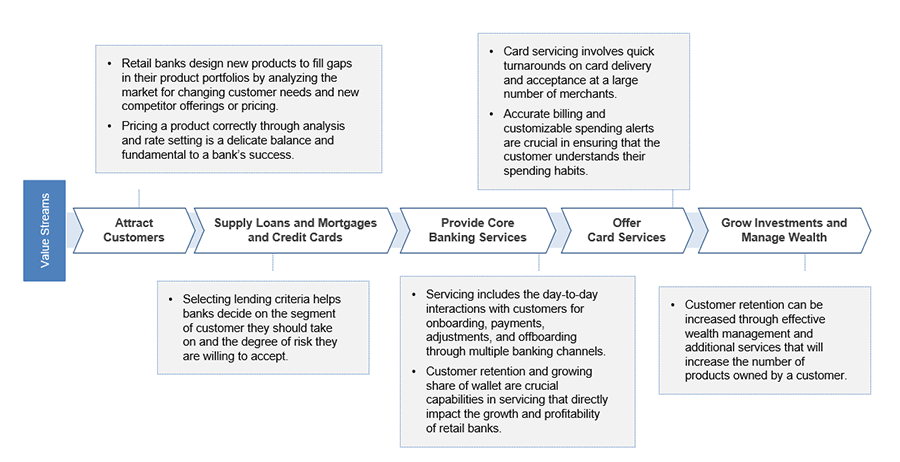
For this value stream, download Info-Tech's Info-Tech's Industry Reference Architecture for Retail Banking.
Example of value streams – Higher Education
Value streams connect business goals to the organisation's value realisation activities.
Example value stream descriptions for: Higher Education
Value streams enable the organisation to create or capture value in the market in which it operates by engaging in a set of interconnected activities.
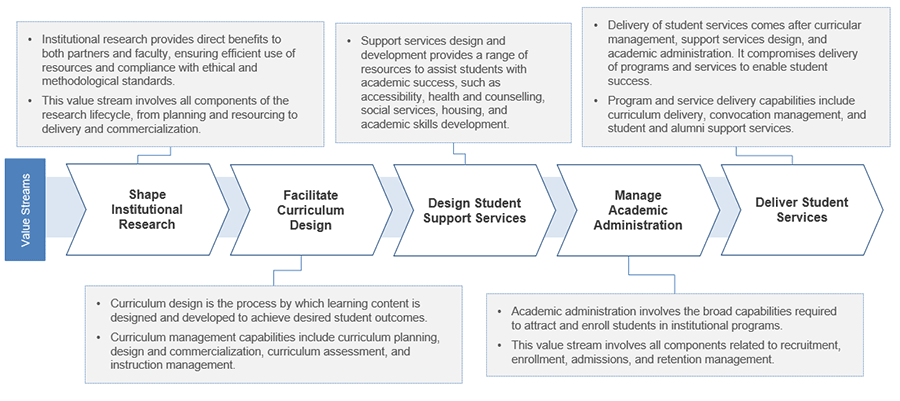
For this value stream, download Info-Tech's Industry Reference Architecture for Higher Education.
Example of value streams – Local Government
Value streams connect business goals to the organisation's value realisation activities.
Example value stream descriptions for: Local Government
Value streams enable the organisation to create or capture value in the market in which it operates by engaging in a set of interconnected activities.
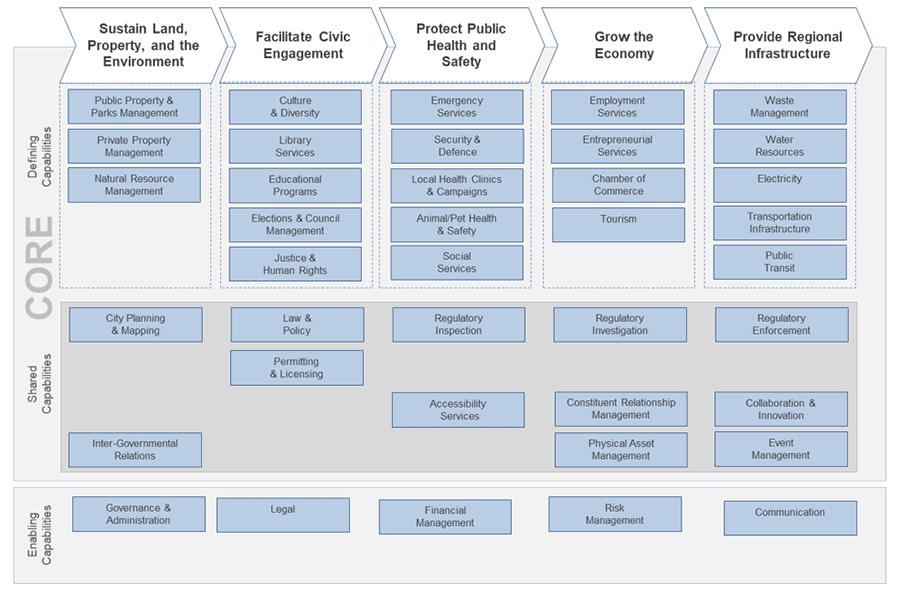
For this value stream, download Info-Tech's Industry Reference Architecture for Local Government.
Example of value streams – Manufacturing
Value streams connect business goals to the organisation's value realisation activities.
Example value stream descriptions for: Manufacturing
Value streams enable the organisation to create or capture value in the market in which it operates by engaging in a set of interconnected activities.
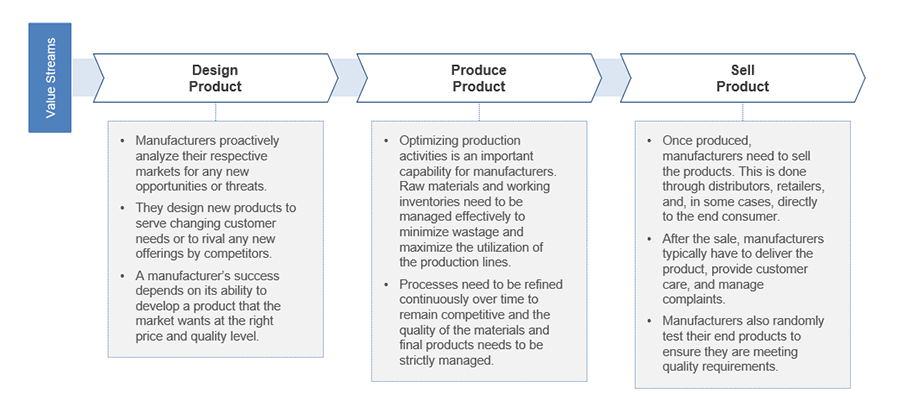
For this value stream, download Info-Tech's Industry Reference Architecture for Manufacturing.
Example of value streams – Retail
Value streams connect business goals to the organisation's value realisation activities.
Example value stream descriptions for: Retail
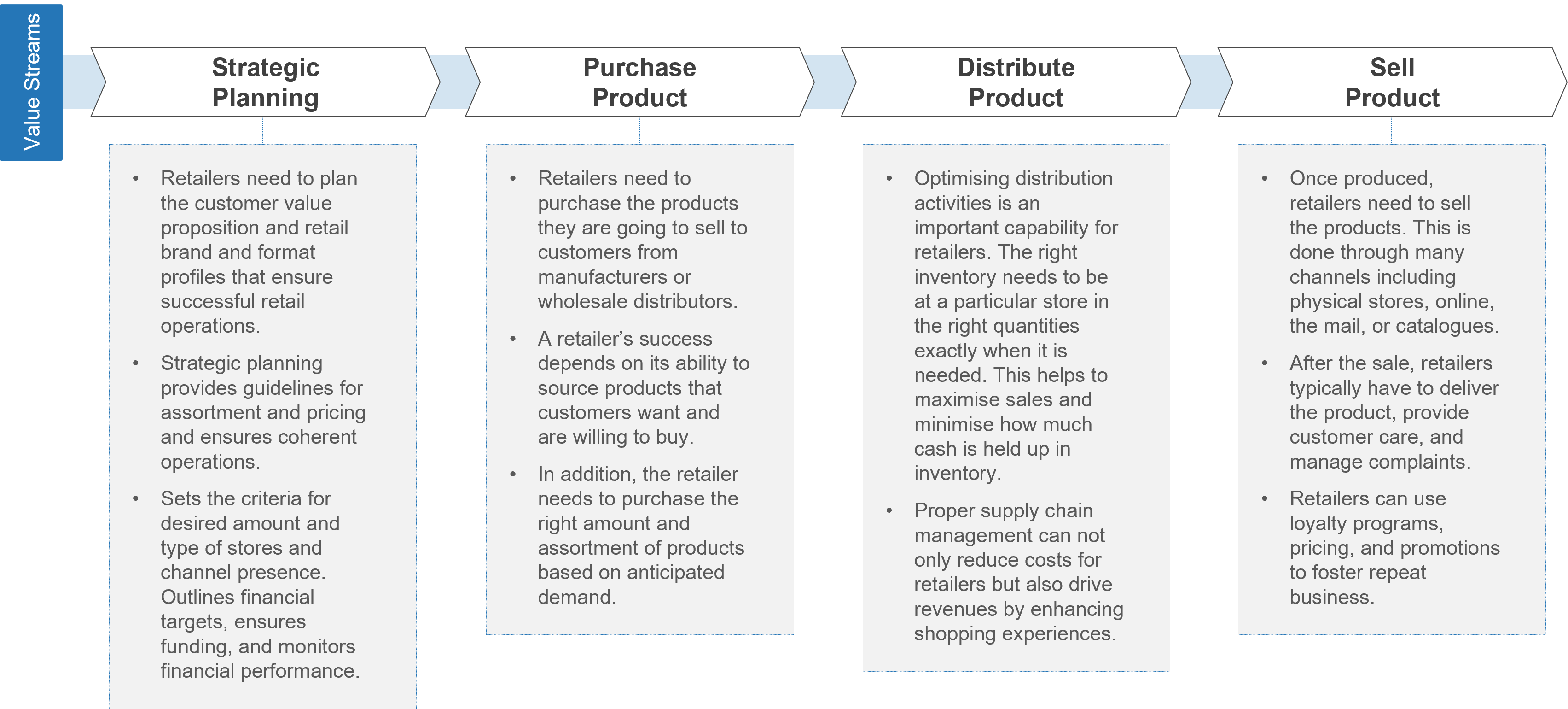
Value streams enable the organisation to create or capture value in the market in which it operates by engaging in a set of interconnected activities.
For this value stream, download Info-Tech's Industry Reference Architecture for Retail.
Define the organisation's business capabilities in a business capability map
A business capability defines what a business does to enable value creation. Business capabilities represent stable business functions and typically will have a defined business outcome.
Business capabilities can be thought of as business terms defined using descriptive nouns such as 'Marketing' or 'Research and Development.'
If your organisation doesn't already have a business capability map, you can leverage the following approach to build one. This initiative requires a good understanding of the business. By working with the right stakeholders, you can develop a business capability map that speaks a common language and accurately depicts your business.
Working with the stakeholders as described above:
- Analyse the value streams to identify and describe the organisation's capabilities that support them.
- Consider: What is the objective of your value stream? (This can highlight which capabilities support which value stream.)
- As you initiate your engagement with your stakeholders, don't start a blank page. Leverage the examples on the next slides as a starting point for your business capability map.
- When using these examples, consider: What are the activities that make up your particular business? Keep the ones that apply to your organisation, remove the ones that don't, and add any needed.
Align data governance to the organisation's value realisation activities.
Info-Tech Insight
A business capability map can be thought of as a visual representation of your organisation's business capabilities and hence represents a view of what your data governance program must support.
For more information, refer to Info-Tech's Document Your Business Architecture.
Example business capability map – Retail Banking
A business capability map can be thought of as a visual representation of your organisation's business capabilities and hence represents a view of what your data governance program must support.
Validate your business capability map with the right stakeholders, including your executive team, business unit leaders, and/or other key stakeholders.
Info-Tech Tip:
Leverage your business capability map verification session with these key stakeholders as a prime opportunity to share and explain the role of data and data governance in supporting the very value realisation capabilities under discussion. This will help to build awareness and visibility of the data governance program.
Example business capability map for: Retail Banking
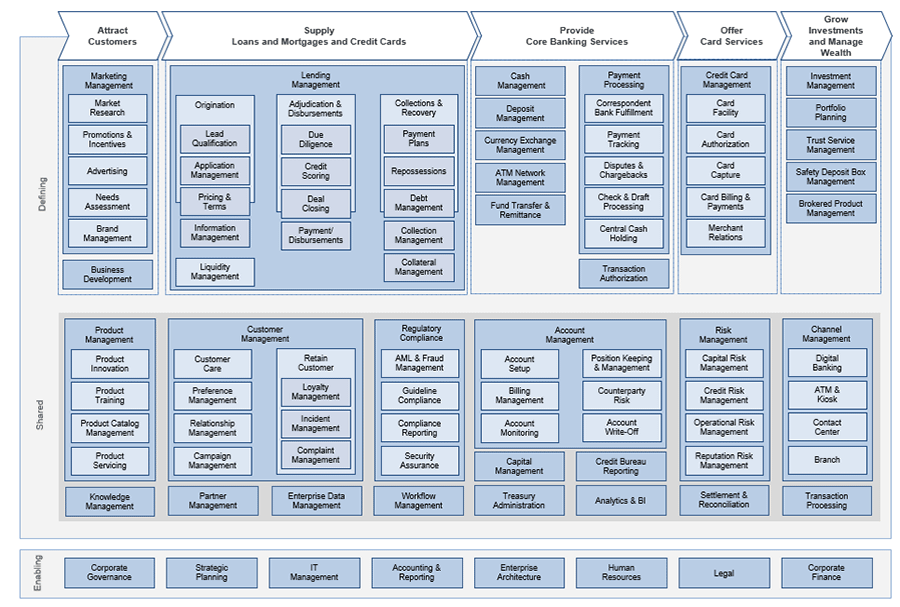
For this business capability map, download Info-Tech's Industry Reference Architecture for Retail Banking.
Example business capability map – Higher Education
A business capability map can be thought of as a visual representation of your organisation's business capabilities and hence represents a view of what your data governance program must support.
Validate your business capability map with the right stakeholders, including your executive team, business unit leaders, and/or other key stakeholders.
Info-Tech Tip:
Leverage your business capability map verification session with these key stakeholders as a prime opportunity to share and explain the role of data and data governance in supporting the very value realisation capabilities under discussion. This will help to build awareness and visibility of the data governance program.
Example business capability map for: Higher Education
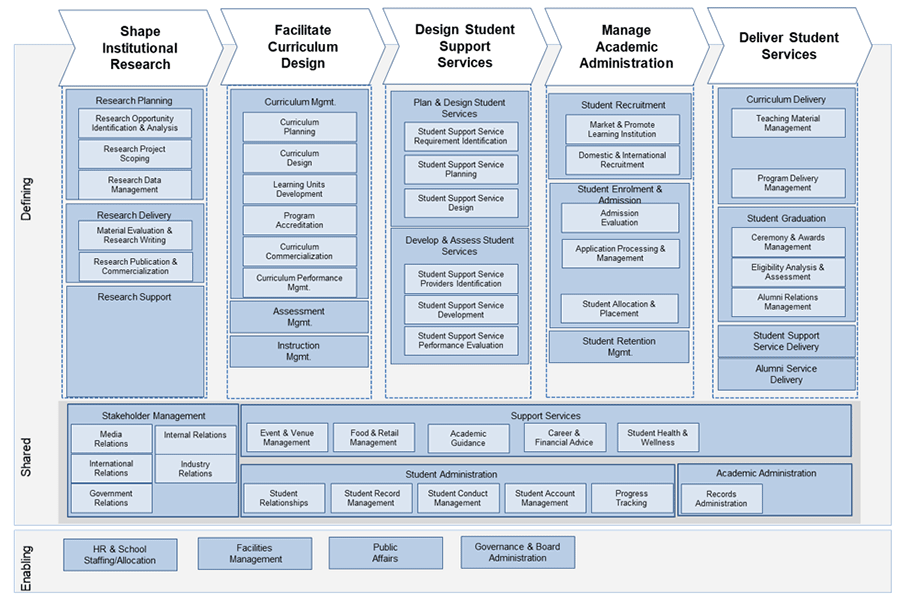
For this business capability map, download Info-Tech's Industry Reference Architecture for Higher Education.
Example business capability map – Local Government
A business capability map can be thought of as a visual representation of your organisation's business capabilities and hence represents a view of what your data governance program must support.
Validate your business capability map with the right stakeholders, including your executive team, business unit leaders, and/or other key stakeholders.
Info-Tech Tip:
Leverage your business capability map verification session with these key stakeholders as a prime opportunity to share and explain the role of data and data governance in supporting the very value realisation capabilities under discussion. This will help to build awareness and visibility of the data governance program.
Example business capability map for: Local Government

For this business capability map, download Info-Tech's Industry Reference Architecture for Local Government.
Example business capability map – Manufacturing
A business capability map can be thought of as a visual representation of your organisation's business capabilities and hence represents a view of what your data governance program must support.
Validate your business capability map with the right stakeholders, including your executive team, business unit leaders, and/or other key stakeholders.
Info-Tech Tip:
Leverage your business capability map verification session with these key stakeholders as a prime opportunity to share and explain the role of data and data governance in supporting the very value realisation capabilities under discussion. This will help to build awareness and visibility of the data governance program.
Example business capability map for: Manufacturing
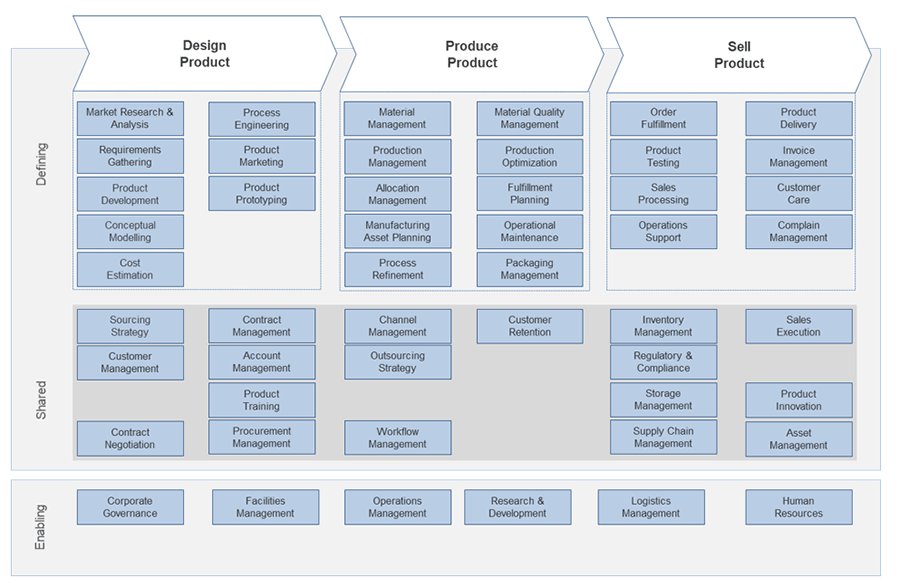
For this business capability map, download Info-Tech's Industry Reference Architecture for Manufacturing.
Example business capability map - Retail
A business capability map can be thought of as a visual representation of your organisation's business capabilities and hence represents a view of what your data governance program must support.
Validate your business capability map with the right stakeholders, including your executive team, business unit leaders, and/or other key stakeholders.
Info-Tech Tip:
Leverage your business capability map verification session with these key stakeholders as a prime opportunity to share and explain the role of data and data governance in supporting the very value realisation capabilities under discussion. This will help to build awareness and visibility of the data governance program.
Example business capability map for: Retail
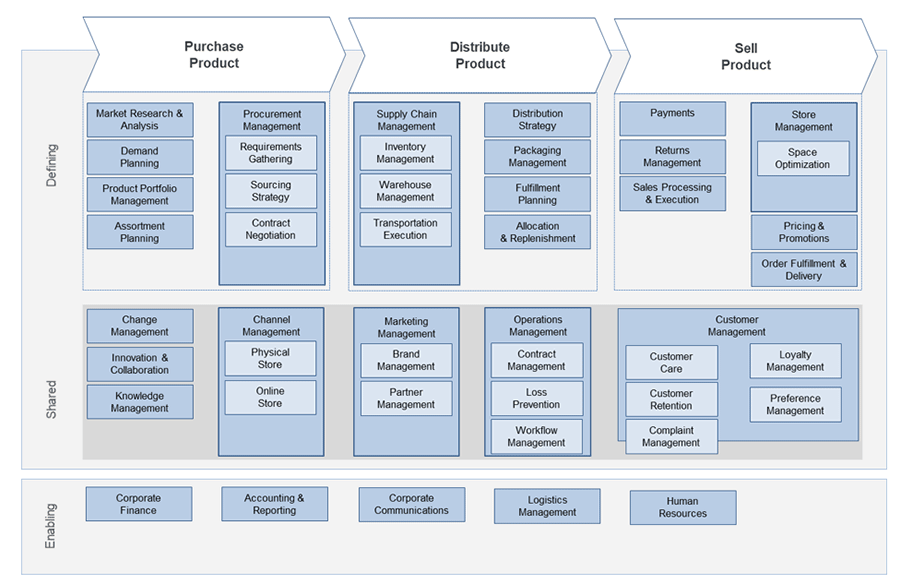
For this business capability map, download Info-Tech's Industry Reference Architecture for Retail.
1.1.2 Categorise Your Organisation's Key Capabilities
Determine which capabilities are considered high priority in your organisation.
- Categorise or heatmap the organisation's key capabilities. Consult with senior and other key business stakeholders to categorise and prioritise the business' capabilities. This will aid in ensuring your data governance future state planning is aligned with the mandate of the business. One approach to prioritising capabilities with business stakeholders is to examine them through the lens of cost advantage creators, competitive advantage differentiators, and/or by high value/high risk.
- Identify cost advantage creators. Focus on capabilities that drive a cost advantage for your organisation. Highlight these capabilities and prioritise programs that support them.
- Identify competitive advantage differentiators. Focus on capabilities that give your organisation an edge over rivals or other players in your industry.
This categorisation/prioritisation exercise helps highlight prime areas of opportunity for building use cases, determining prioritisation, and the overall optimisation of data and data governance.
Input
- Strategic insight from senior business stakeholders on the business capabilities that drive value for the organisation
Output
- Business capabilities categorised and prioritised (e.g. cost advantage creators, competitive advantage differentiators, high value/high risk)
Materials
- Your existing business capability map or the business capability map derived in the previous activity
Participants
- Key business stakeholders
- Data stewards
- Data custodians
- Data Governance Working Group
For more information, refer to Info-Tech's Document Your Business Architecture.
Example of business capabilities categorisation or heatmapping – Retail
This exercise is useful in ensuring the data governance program is focused and aligned to support the priorities and direction of the business.
- Depending on the mandate from the business, priority may be on developing cost advantage. Hence the capabilities that deliver efficiency gains are the ones considered to be cost advantage creators.
- The business' priority may be on maintaining or gaining a competitive advantage over its industry counterparts. Differentiation might be achieved in delivering unique or enhanced products, services, and/or experiences, and the focus will tend to be on the capabilities that are more end-stakeholder-facing (e.g. customer-, student-, patient,- and/or constituent-facing). These are the organisation's competitive advantage creators.
Example: Retail
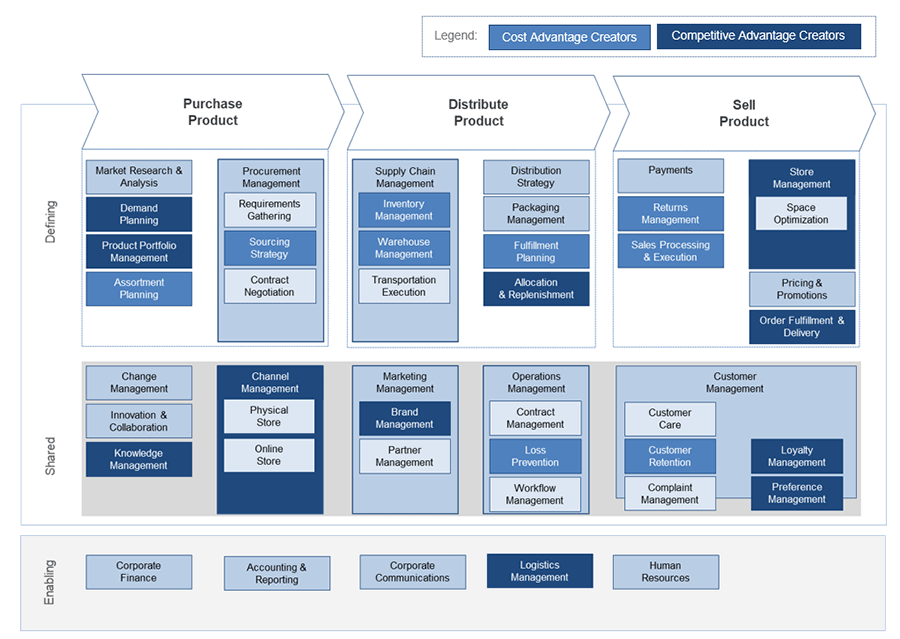
For this business capability map, download Info-Tech's Industry Reference Architecture for Retail.
1.1.3 Develop a Strategy Map Tied to Data Governance
Identify the strategic objectives for the business. Knowing the key strategic objectives will drive business-data governance alignment. It's important to make sure the right strategic objectives of the organisation have been identified and are well understood.
- Meet with senior business leaders and other relevant stakeholders to help identify and document the key strategic objectives for the business.
- Leverage their knowledge of the organisation's business strategy and strategic priorities to visually represent how these map to value streams, business capabilities, and, ultimately, to data and data governance needs and initiatives. Tip: Your map is one way to visually communicate and link the business strategy to other levels of the organisation.
- Confirm the strategy mapping with other relevant stakeholders.
Guide to creating your map: Starting with strategic objectives, map the value streams that will ultimately drive them. Next, link the key capabilities that enable each value stream. Then map the data and data governance to initiatives that support those capabilities. This is one approach to help you prioritise the data initiatives that deliver the most value to the organisation.
Input
- Strategic objectives as outlined by the organisation's business strategy and confirmed by senior leaders
Output
- A strategy map that maps your organisational strategic objectives to value streams, business capabilities, and, ultimately, to data program
Materials
- Your existing business capability map or the one created in the previous step
- The strategy map template provided in the Data Governance Planning and Roadmapping Workbook
- Business strategy
Participants
- Key business stakeholders
- Data stewards
- Data custodians
- Data Governance Working Group
Download Info-Tech's Data Governance Planning and Roadmapping Workbook
Example of a strategy map tied to data governance
- Strategic objectives are the outcomes that the organisation is looking to achieve.
- Value streams enable an organisation to create and capture value in the market through interconnected activities that support strategic objectives.
- Business capabilities define what a business does to enable value creation in value streams.
- Data capabilities and initiatives are descriptions of action items on the data and data governance roadmap and which will enable one or multiple business capabilities in its desired target state.
Info-Tech Tip:
Start with the strategic objectives, then map the value streams that will ultimately drive them. Next, link the key capabilities that enable each value stream. Then map the data and data governance initiatives that support those capabilities. This process will help you prioritise the data initiatives that deliver the most value to the organisation.
Example: Retail
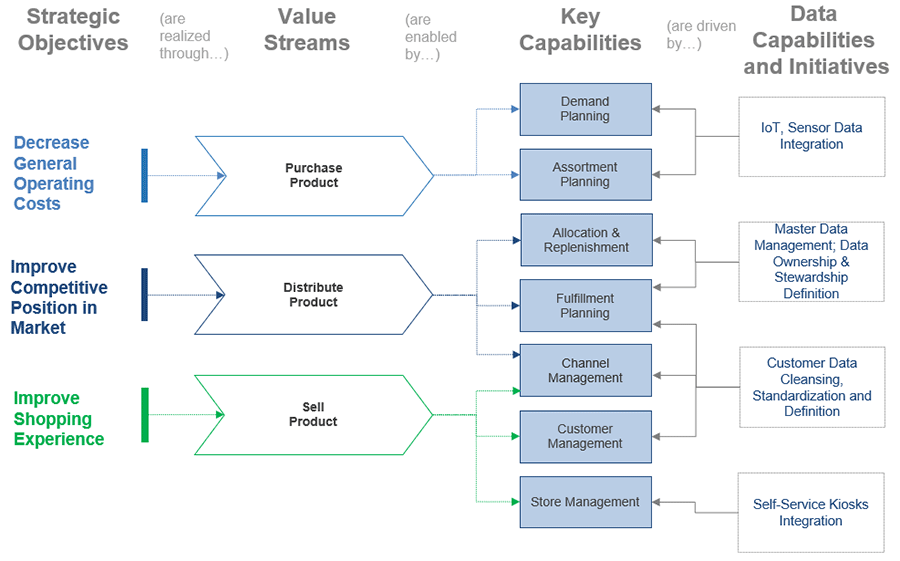
For this strategy map, download Info-Tech's Industry Reference Architecture for Retail.
Step 1.2
Build High-Value Use Cases for Data Governance
Activities
1.2.1 Build High-Value Use Cases
This step will guide you through the following activities:
- Leveraging your categorised business capability map to conduct deep-dive sessions with key business stakeholders for creating high-value uses cases
- Discussing current challenges, risks, and opportunities associated with the use of data across the lines of business
- Exploring which other business capabilities, stakeholder groups, and business units will be impacted
Outcomes of this step
- Relevant use cases that articulate the data-related challenges, needs, or opportunities that are clear and contained and, if addressed ,will deliver value to the organisation
Info-Tech Tip
One of the most important aspects when building use cases is to ensure you include KPIs or measures of success. You have to be able to demonstrate how the use case ties back to the organisational priorities or delivers measurable business value. Leverage the KPIs and success factors of the business capabilities tied to each particular use case.
1.2.1 Build High-Value Use Cases
This business needs-gathering activity will highlight and create relevant use cases around data-related problems or opportunities that are clear and contained and, if addressed, will deliver value to the organisation.
- Bring together key business stakeholders (data owner, stewards, SMEs) from a particular line of business as well as the relevant data custodian(s) to build cases for their units. Leverage the business capability map you created for facilitating this act.
- Leverage Info-Tech's framework for data requirements and methodology for creating use cases, as outlined in the Data Use Case Framework Template and seen on the next slide.
- Have the stakeholders move through each breakout session outlined in the Use Case Worksheet. Use flip charts or a whiteboard to brainstorm and document their thoughts.
- Debrief and document results in the Data Use Case Framework Template.
- Repeat this exercise with as many lines of the business as possible, leveraging your business capability map to guide your progress and align with business value.
Tip: Don't conclude these use case discussions without substantiating what measures of success will be used to demonstrate the business value of the effort to produce the desired future state, as relevant to each particular use case.
This business needs-gathering activity will highlight and create relevant use cases around data-related problems or opportunities that are clear and contained and, if addressed, will deliver value to the organisation.
- Bring together key business stakeholders (data owner, stewards, SMEs) from a particular line of business as well the relevant data custodian(s) to build cases for their units. Leverage the business capability map you created for facilitating this act.
- Leverage Info-Tech's framework for data requirements and methodology for creating use cases, as outlined in the Data Use Case Framework Template and seen on the next slide.
- Have the stakeholders move through each breakout session outlined in the Use Case Worksheet. Use flip charts or a whiteboard to brainstorm and document their thoughts.
- Debrief and document results in the Data Use Case Framework Template
- Repeat this exercise with as many lines of the business as possible, leveraging your business capability map to guide your progress and align with business value.
Tip: Don't conclude these use case discussions without substantiating what measures of success will be used to demonstrate the business value of the effort to produce the desired future state, as relevant to each particular use case.
Input
- Value streams and business capabilities as defined by business leaders
- Business stakeholders' subject area expertise
- Data custodian systems, integration, and data knowledge
Output
- Use cases that articulate data-related challenges, needs or opportunities that are tied to defined business capabilities and hence if addressed will deliver measurable value to the organisation.
Materials
- Your business capability map from activity 1.1.1
- Info-Tech's Data Use Case Framework Template
- Whiteboard or flip charts (or shared screen if working remotely)
- Markers/pens
Participants
- Key business stakeholders
- Data stewards and business SMEs
- Data custodians
- Data Governance Working Group
Download Info-Tech's Data Use Case Framework Template
Info-Tech's Framework for Building Use Cases
Objective: This business needs-gathering activity will highlight and create relevant use cases around data-related problems or opportunities that are clear and contained and, if addressed, will deliver value to the organisation.
Leveraging your business capability map, build use cases that align with the organisation's key business capabilities.
Consider:
- Is the business capability a cost advantage creator or an industry differentiator?
- Is the business capability currently underserved by data?
- Does this need to be addressed? If so, is this risk- or value-driven?
Info-Tech's Data Requirements and Mapping Methodology for Creating Use Cases
- What business capability (or capabilities) is this use case tied to for your business area(s)?
- What are your data-related challenges in performing this today?
- What are the steps in this process/activity today?
- What are the applications/systems used at each step today?
- What data domains are involved, created, used, and/or transformed at each step today?
- What does an ideal or improved state look like?
- What other business units, business capabilities, activities, and/or processes will be impacted or improved if this issue was solved?
- Who are the stakeholders impacted by these changes? Who needs to be consulted?
- What are the risks to the organisation (business capability, revenue, reputation, customer loyalty, etc.) if this is not addressed?
- What compliance, regulatory, and/or policy concerns do we need to consider in any solution?
- What measures of success or change should we use to prove the value of the effort (such as KPIs, ROI)? What is the measurable business value of doing this?
The resulting use cases are to be prioritised and leveraged for informing the business case and the data governance capabilities optimisation plan.
Taken from Info-Tech's Data Use Case Framework Template
Phase 2
Understand Your Current Data Governance Capabilities
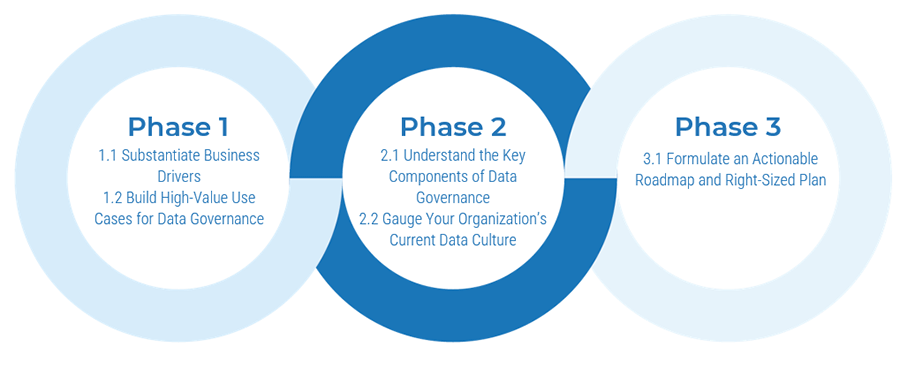
This phase will guide you through the following activities:
- Understand the Key Components of Data Governance
- Gauge Your Organisation's Current Data Culture
This phase involves the following participants:
- Data Leadership
- Data Ownership & Stewardship
- Policies & Procedures
- Data Literacy & Culture
- Operating Model
- Data Management
- Data Privacy & Security
- Enterprise Projects & Services
Step 2.1
Understand the Key Components of Data Governance
This step will guide you through the following activities:
- Understanding the core components of an effective data governance program and determining your organisation's current capabilities in these areas:
- Data Leadership
- Data Ownership & Stewardship
- Policies & Procedures
- Data Literacy & Culture
- Operating Model
- Data Management
- Data Privacy & Security
- Enterprise Projects & Services
Outcomes of this step
- An understanding of the core components of an effective data governance program
- An understanding your organisation's current data governance capabilities
Leverage Info-Tech's: Data Governance Initiative Planning and Roadmap Tool to assess your current data governance capabilities and plot your target state accordingly.
This tool will help your organisation plan the sequence of activities, capture start dates and expected completion dates, and create a roadmap that can be effectively communicated to the organisation.
Review: Info-Tech's Data Governance Framework
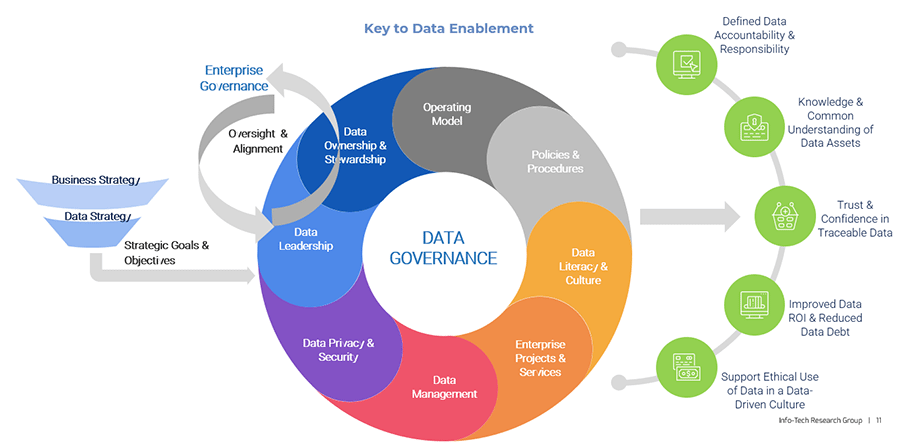
Key components of data governance
A well-defined data governance program will deliver:
- Defined accountability and responsibility for data.
- Improved knowledge and common understanding of the organisation's data assets.
- Elevated trust and confidence in traceable data.
- Improved data ROI and reduced data debt.
- An enabling framework for supporting the ethical use and handling of data.
- A foundation for building and fostering a data-driven and data-literate organisational culture.
The key components of establishing sustainable enterprise data governance, taken from Info-Tech's Data Governance Framework:
- Data Leadership
- Data Ownership & Stewardship
- Operating Model
- Policies & Procedures
- Data Literacy & Culture
- Data Management
- Data Privacy & Security
- Enterprise Projects & Services
Data Leadership
- Data governance needs a dedicated head or leader to steer the organisation's data governance program.
- For organisations that do have a chief data officer (CDO), their office is the ideal and effective home for data governance.
- Heads of data governance also have titles such as director of data governance, director of data quality, and director of analytics.
- The head of your data governance program works with all stakeholders and partners to ensure there is continuous enterprise governance alignment and oversight and to drive the program's direction.
- While key stakeholders from the business and IT will play vital data governance roles, the head of data governance steers the various components, stakeholders, and initiatives, and provides oversight of the overall program.
- Vital data governance roles include: data owners, data stewards, data custodians, data governance steering committee (or your organisation's equivalent), and any data governance working group(s).
The role of the CDO: the voice of data
The office of the chief data officer (CDO):
- Has a cross-organisational vision and strategy for data.
- Owns and drives the data strategy; ensures it supports the overall organisational strategic direction and business goals.
- Leads the organisational data initiatives, including data governance
- Is accountable for the policy, strategy, data standards, and data literacy necessary for the organisation to operate effectively.
- Educates users and leaders about what it means to be 'data-driven.'
- Builds and fosters a culture of data excellence.
'Compared to most of their C-suite colleagues, the CDO is faced with a unique set of problems. The role is still being defined. The chief data officer is bringing a new dimension and focus to the organisation: "data." '
– Carruthers and Jackson, 2020
Who does the CDO report to?
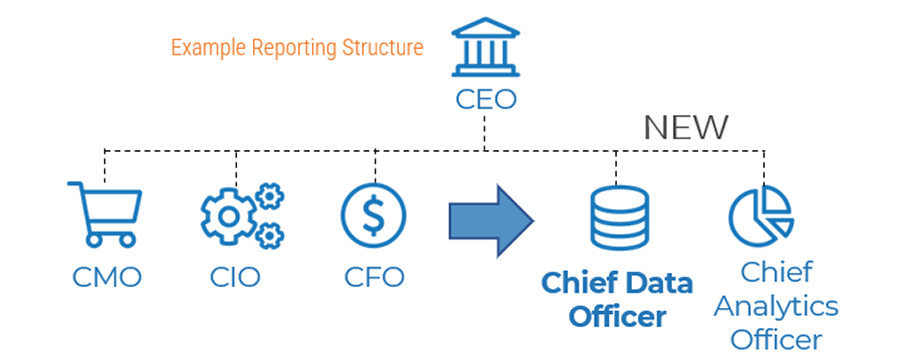
- The CDO should be a true C- level executive.
- Where the organisation places the CDO role in the structure sends an important signal to the business about how much it values data.
'The title matters. In my opinion, you can't have a CDO without executive authority. Otherwise no one will listen.'
– Anonymous European CDO
'The reporting structure depends on who's the 'glue' that ties together all these uniquely skilled individuals.'
– John Kemp, Senior Director, Executive Services, Info-Tech Research Group
Data Ownership & Stewardship
Who are best suited to be data owners?
- Wherever they may sit in your organisation, data owners will typically have the highest stake in that data.
- Data owners needs to be suitably senior and have the necessary decision-making power.
- They have the highest interest in the related business data domain, whether they are the head of a business unit or the head of a line of business that produces data or consumes data (or both).
- If they are neither of these, it's unlikely they will have the interest in the data (in terms of its quality, protection, ethical use, and handling, for instance) necessary to undertake and adopt the role effectively.
Data owners are typically senior business leaders with the following characteristics:
- Positioned to accept accountability for their data domain.
- Hold authority and influence to affect change, including across business processes and systems, needed to improve data quality, use, handling, integration, etc.
- Have access to a budget and resources for data initiatives such as resolving data quality issues, data cleansing initiatives, business data catalogue build, related tools and technology, policy management, etc.
- Hold the influence needed to drive change in behaviour and culture.
- Act as ambassadors of data and its value as an organisational strategic asset.
Right-size your data governance organisational structure
- Most organisations strive to identify roles and responsibilities at a strategic, and operational level. Several factors will influence the structure of the program such as the focus of the data governance project as well as the maturity and size of the organisation.
- Your data governance structure has to work for your organisation, and it has to evolve as the organisation evolves.
- Formulate your blend of data governance roles, committees, councils, and cross-functional groups, that make sense for your organisation.
- Your data governance organisational structure should not add complexity or bureaucracy to your organisation's data landscape; it should support and enable your principle of treating data as an asset.
There is no one-size-fits-all data governance organisational structure.
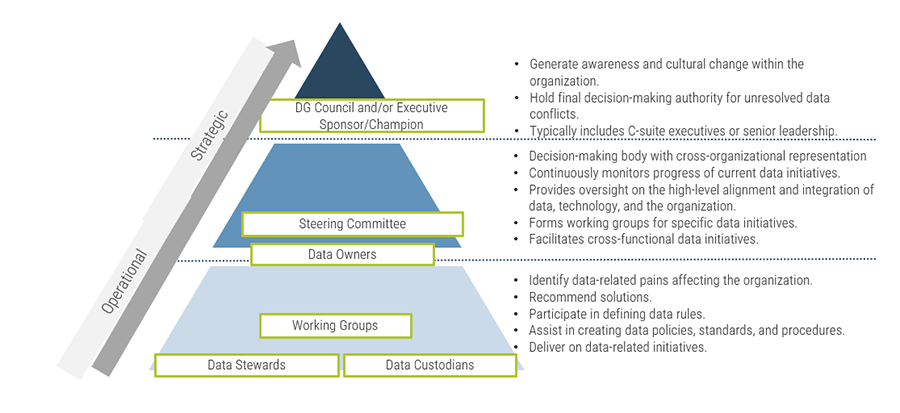
Critical roles and responsibilities for data governance
Data Governance Working Groups
Data governance working groups:
- Are cross-functional teams
- Deliver on data governance projects, initiatives, and ad hoc review committees.
Data Stewards
Traditionally, data stewards:
- Serve on an operational level addressing issues related to adherence to standards/procedures, monitoring data quality, raising issues identified, etc.
- Are responsible for managing access, quality, escalating issues, etc.
Data Custodians
- Traditionally, data custodians:
- Serve on an operational level addressing issues related to data and database administration.
- Support the management of access, data quality, escalating issues, etc.
- Are SMEs from IT and database administration.
Example: Business capabilities to data owner and data stewards mapping for a selected data domain
Info-Tech Insight
Your organisation's value streams and the associated business capabilities require effectively governed data. Without this, you face elevated operational costs, missed opportunities, eroded stakeholder satisfaction, and exposure to increased business risk.
Enabling business capabilities with data governance role definitions
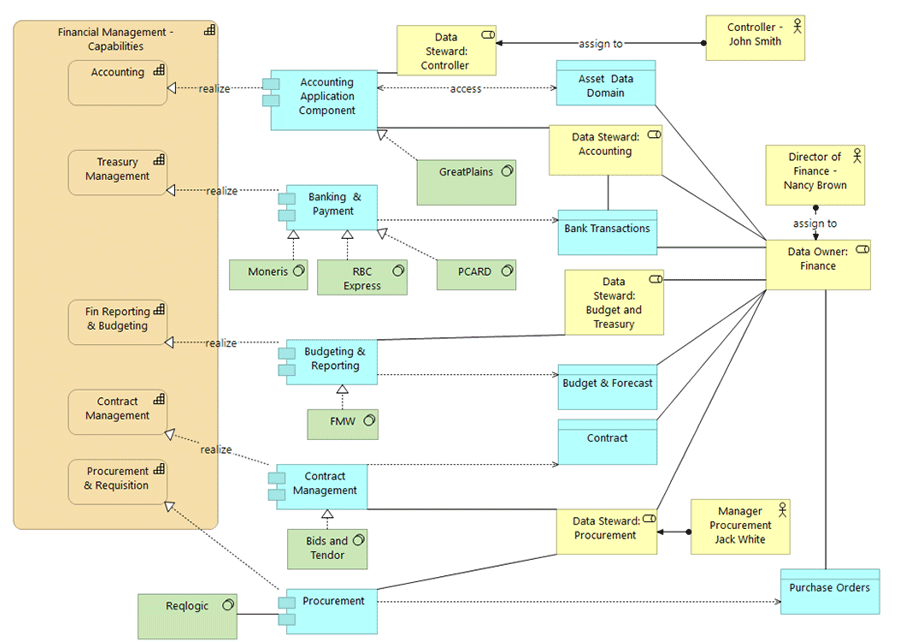
Operating Model
Your operating model is the key to designing and operationalizing a form of data governance that delivers measurable business value to your organisation.
'Generate excitement for data: When people are excited and committed to the vision of data enablement, they're more likely to help ensure that data is high quality and safe.' – Petzold, et al., 2020
Operating Model
Defining your data governance operating model will help create a well-oiled program that sustainably delivers value to the organisation and manages risks while building and fostering a culture of data excellence along the way. Some organisations are able to establish a formal data governance office, whether independent or attached to the office of the chief data officer. Regardless of how you are organised, data governance requires a home, a leader, and an operating model to ensure its sustainability and evolution.
Examples of focus areas for your operating model:
- Delivery: While there are core tenets to every data governance program, there is a level of variability in the implementation of data governance programs across organisations, sectors, and industries. Every organisation has its own particular drivers and mandates, so the level and rigour applied will also vary.
- Communication: Communication is vital across all levels and stakeholder groups. For instance, there needs to be communication from the data governance office up to senior leadership, as well as communication within the data governance organisation, which is typically made up of the data governance steering committee, data governance council, executive sponsor/champion, data stewards, and data custodians and working groups.
The key is to determine what style will work best in your organisation, taking into consideration your organisational culture, executive leadership support (present and ongoing), catalysts such as other enterprise-wide transformative and modernisation initiatives, and/or regulatory and compliances drivers.
Furthermore, communication with the wider organisation of data producers, users, and consumers is one of the core elements of the overall data governance communications plan.
Communication is vital for ensuring acceptance of new processes, rules, guidelines, and technologies by all data producers and users as well as for sharing success stories of the program.
Operating Model
Tie the value of data governance and its initiatives back to the business capabilities that are enabled.
'Leading organisations invest in change management to build data supporters and convert the sceptics. This can be the most difficult part of the program, as it requires motivating employees to use data and encouraging producers to share it (and ideally improve its quality at the source)[.]' – Petzold, et al., 2020
Operating Model
Examples of focus areas for your operating model (continued):
- Change management and issue resolution: Data governance initiatives will very likely bring about a level of organisational disruption, with governance recommendations and future state requiring potentially significant business change. This may include a redesign of a substantial number of data processes affecting various business units, which will require tweaking the organisation's culture, thought processes, and procedures surrounding its data.
- Performance measuring, monitoring and reporting: Measuring and reporting on performance, successes, and realisation of tangible business value are a must for sustaining, growing, and scaling your data governance program.
Preparing people for change well in advance will allow them to take the steps necessary to adapt and reduce potential confrontation. By planning for and efficiently communicating any changes that a data governance initiative may bring, many initial issues can be resolved from the outset.
Attempting to implement change without an effective communications plan can result in disagreements over data control and stalemates between stakeholder units. The recommendations of the governance group must reflect the needs of all stakeholders or there will be pushback.
Aligning your data governance to the organisation's value realisation activities enables you to leverage the KPIs of those business capabilities to demonstrate tangible and measurable value. Use terms and language that will resonate with your senior business leadership.
Info-Tech Tip:
Launching a data governance program will bring with it a level of disruption to the culture of the organisation. That disruption doesn't have to be detrimental if you are prepared to manage the change proactively and effectively.
Policies, Procedures & Standards
'Data standards are the rules by which data are described and recorded. In order to share, exchange, and understand data, we must standardise the format as well as the meaning.' – U.S. Geological Survey
Policies, Procedures & Standards
- When defining, updating, or refreshing your data policies, procedures, and standards, ensure they are relevant, serve a purpose, and/or support the use of data in the organisation.
- Avoid the common pitfall of building out a host of policies, procedures, and standards that are never used or followed by users and therefore don't bring value or serve to mitigate risk for the organisation.
- Data policies can be thought of as formal statements and are typically created, approved, and updated by the organisation's data decision-making body (such as a data governance steering committee).
- Data standards and procedures function as actions, or rules, that support the policies and their statements.
- Standards and procedures are designed to standardise the processes during the overall data lifecycle. Procedures are instructions to achieve the objectives of the policies. The procedures are iterative and will be updated with approval from your data governance committee as needed.
- Your organisation's data policies, standards, and procedures should not bog down or inhibit users; rather, they should enable confident data use and handling across the overall data lifecycle. They should support more effective and seamless data capture, integration, aggregation, sharing, and retention of data in the organisation.
Examples of data policies:
- Data Classification Policy
- Data Retention Policy
- Data Entry Policy
- Data Backup Policy
- Data Provenance Policy
- Data Management Policy
See Info-Tech's Data Governance Policy Template: This policy establishes uniformed data governance standards and identifies the shared responsibilities for assuring the integrity of the data and that it efficiently and effectively serves the needs of your organisation.
Data Domain Documentation
Select the correct granularity for your business need
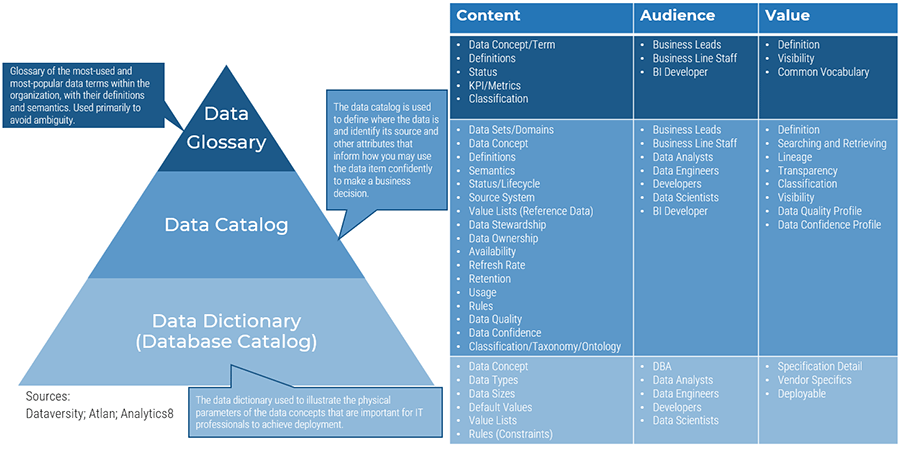
Sources: Dataversity; Atlan; Analytics8
Data Domain Documentation Examples
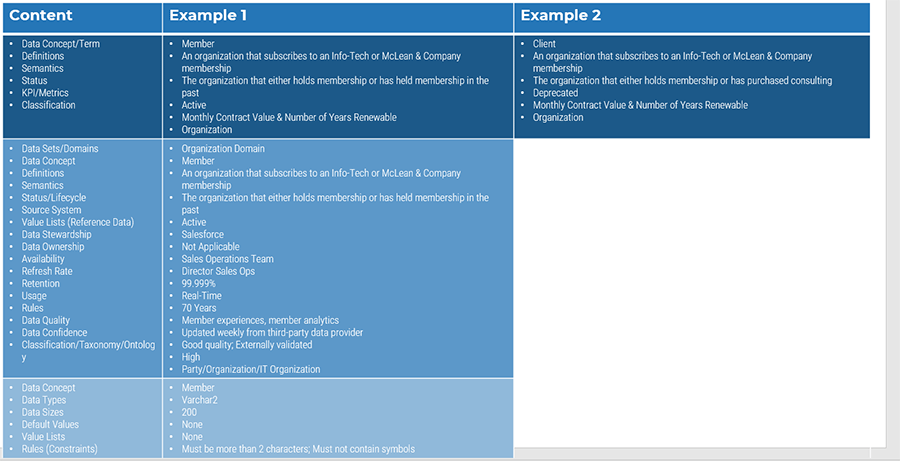
Data Culture
'Organisational culture can accelerate the application of analytics, amplify its power, and steer companies away from risky outcomes.' – Petzold, et al., 2020
A healthy data culture is key to amplifying the power of your data and to building and sustaining an effective data governance program.
What does a healthy data culture look like?
- Everybody knows the data.
- Everybody trusts the data.
- Everybody talks about the data.
Building a culture of data excellence.
Leverage Info-Tech's Data Culture Diagnostic to understand your organisation's culture around data.
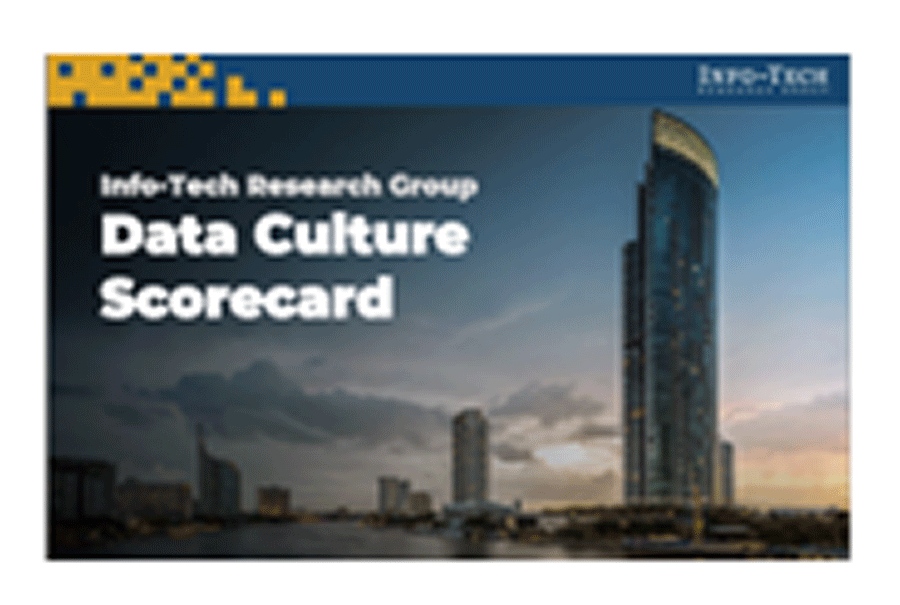
Contact your Info-Tech Account Representative for more information on the Data Culture Diagnostic
Cultivating a data-driven culture is not easy
'People are at the heart of every culture, and one of the biggest challenges to creating a data culture is bringing everyone into the fold.' – Lim, Alation
It cannot be purchased or manufactured,
It must be nurtured and developed,
And it must evolve as the business, user, and data landscapes evolve.
'Companies that have succeeded in their data-driven efforts understand that forging a data culture is a relentless pursuit, and magic bullets and bromides do not deliver results.' – Randy Bean, 2020
Hallmarks of a data-driven culture
There is a trusted, single source of data the whole company can draw from.
There's a business glossary and data catalogue and users know what the data fields mean.
Users have access to data and analytics tools. Employees can leverage data immediately to resolve a situation, perform an activity, or make a decision – including frontline workers.
Data literacy, the ability to collect, manage, evaluate, and apply data in a critical manner, is high.
Data is used for decision making. The company encourages decisions based on objective data and the intelligent application of it.
A data-driven culture requires a number of elements:
- High-quality data
- Broad access and data literacy
- Data-driven decision-making processes
- Effective communication
Data Literacy
Data literacy is an essential part of a data-driven culture.
- Building a data-driven culture takes an ongoing investment of time, effort, and money.
- This investment will not realise its full return without building up the organisation's data literacy.
- Data literacy is about filling data knowledge gaps across all levels of the organisation.
- It's about ensuring all users – senior leadership right through to core users – are equipped with appropriate levels of training, skills, understanding, and awareness around the organisation's data and the use of associated tools and technologies. Data literacy ensures users have the data they need and they know how to interpret and leverage it.
- Data literacy drives the appetite, demand, and consumption for data.
- A data-literate culture is one where the users feel confident and skilled in their use of data, leveraging it for making informed or evidence-based decisions and generating insights for the organisation.
Data Management
- Data governance serves as an enabler to all of the core components that make up data management:
- Data quality management
- Data architecture management
- Data platform
- Data integration
- Data operations management
- Data risk management
- Reference and master data management (MDM)
- Document and content management
- Metadata management
- Business intelligence (BI), reporting, analytics and advanced analytics, artificial intelligence (AI), machine learning (ML)
- Key tools such as the business data glossary and data catalogue are vital for operationalizing data governance and in supporting data management disciplines such as data quality management, metadata management, and MDM as well as BI, reporting, and analytics.
Enterprise Projects & Services
- Data governance serves as an enabler to enterprise projects and services that require, use, share, sell, and/or rely on data for their viability and, ultimately, their success.
- Folding or embedding data governance into the organisation's project management function or project management office (PMO) serves to ensure that, for any initiative, suitable consideration is given to how data is treated.
- This may include defining parameters, following standards and procedures around bringing in new sources of data, integrating that data into the organisation's data ecosystem, using and sharing that data, and retaining that data post-project completion.
- The data governance function helps to identify and manage any ethical issues, whether at the start of the project and/or throughout.
- It provides a foundation for asking relevant questions as it relates to the use or incorporation of data in delivering the specific project or service. Do we know where the data obtained from? Do we have rights to use that data? Are there legislations, policies, or regulations that guide or dictate how that data can be used? What are the positive effects, negative impacts, and/or risks associated with our intended use of that data? Are we positioned to mitigate those risks?
- Mature data governance creates organisations where the above considerations around data management and the ethical use and handling of data is routinely implemented across the business and in the rollout and delivery of projects and services.
Data Privacy & Security
- Data governance supports the organisation's data privacy and security functions.
- Key tools include the data classification policy and standards and defined roles around data ownership and data stewardship. These are vital for operationalizing data governance and supporting data privacy, security, and the ethical use and handling of data.
- While some organisations may have a dedicated data security and privacy group, data governance provides an added level of oversight in this regard.
- Some of the typical checks and balances include ensuring:
- There are policies and procedures in place to restrict and monitor staff's access to data (one common way this is done is according to job descriptions and responsibilities) and that these comply with relevant laws and regulations.
- There's a data classification scheme in place where data has been classified on a hierarchy of sensitivity (e.g. top secret, confidential, internal, limited, public).
- The organisation has a comprehensive data security framework, including administrative, physical, and technical procedures for addressing data security issues (e.g. password management and regular training).
- Risk assessments are conducted, including an evaluation of risks and vulnerabilities related to intentional and unintentional misuse of data.
- Policies and procedures are in place to mitigate the risks associated with incidents such as data breaches.
- The organisation regularly audits and monitors its data security.
Ethical Use & Handling of Data
Data governance will support your organisation's ethical use and handling of data by facilitating definition around important factors, such as:
- What are the various data assets in the organisation and what purpose(s) can they be used for? Are there any limitations?
- Who is the related data owner? Who holds accountability for that data? Who will be answerable?
- Where was the data obtained from? What is the intended use of that data? Do you have rights to use that data? Are there legislations, policies, or regulations that guide or dictate how that data can be used?
- What are the positive effects, negative impacts, and/or risks associated with the use of that data?
Ethical Use & Handling of Data
- Data governance serves as an enabler to the ethical use and handling of an organisation's data.
- The Open Data Institute (ODI) defines data ethics as: 'A branch of ethics that evaluates data practices with the potential to adversely impact on people and society – in data collection, sharing and use.'
- Data ethics relates to good practice around how data is collected, used and shared. It's especially relevant when data activities have the potential to impact people and society, whether directly or indirectly (Open Data Institute, 2019).
- A failure to handle and use data ethically can negatively impact an organisation's direct stakeholders and/or the public at large, lead to a loss of trust and confidence in the organisation's products and services, lead to financial loss, and impact the organisation's brand, reputation, and legal standing.
- Data governance plays a vital role is building and managing your data assets, knowing what data you have, and knowing the limitations of that data. Data ownership, data stewardship, and your data governance decision-making body are key tenets and foundational components of your data governance. They enable an organisation to define, categorise, and confidently make decisions about its data.
Step 2.2
Gauge Your Organisation's Current Data Culture
Activities
2.2.1 Gauge Your Organisation's Current Data Culture
This step will guide you through the following activities:
- Conduct a data culture survey or leverage Info-Tech's Data Culture Diagnostic to increase your understanding of your organisation's data culture
Outcomes of this step
- An understanding of your organisational data culture
2.2.1 Gauge Your Organisation's Current Data Culture
Conduct a Data Culture Survey or Diagnostic
The objectives of conducting a data culture survey are to increase the understanding of the organisation's data culture, your users' appetite for data, and their appreciation for data in terms of governance, quality, accessibility, ownership, and stewardship. To perform a data culture survey:
- Identify members of the data user base, data consumers, and other key stakeholders for surveying.
- Conduct an information session to introduce Info-Tech's Data Culture Diagnostic survey. Explain the objective and importance of the survey and its role in helping to understand the organisation's current data culture and inform the improvement of that culture.
- Roll out the Info-Tech Data Culture Diagnostic survey to the identified users and stakeholders.
- Debrief and document the results and scorecard in the Data Strategy Stakeholder Interview Guide and Findings document.
Input
- Email addresses of participants in your organisation who should receive the survey
Output
- Your organisation's Data Culture Scorecard for understanding current data culture as it relates to the use and consumption of data
- An understanding of whether data is currently perceived to be an asset to the organisation
Materials
- Info-Tech's Data Culture Diagnostic service

Participants
- Participants include those at the senior leadership level through to middle management, as well as other business stakeholders at varying levels across the organisation
- Data owners, stewards, and custodians
- Core data users and consumers
Contact your Info-Tech Account Representative for details on launching a Data Culture Diagnostic.
Phase 3
Build a Target State Roadmap and Plan
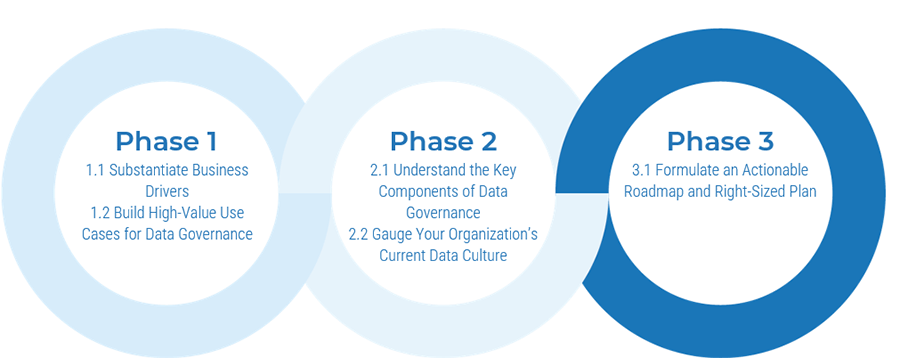
'Achieving data success is a journey, not a sprint. Companies that set a clear course, with reasonable expectations and phased results over a period of time, get to the destination faster.' – Randy Bean, 2020
This phase will guide you through the following activities:
- Build your Data Governance Roadmap
- Develop a target state plan comprising of prioritised initiatives
This phase involves the following participants:
- Data Governance Leadership
- Data Owners/Data Stewards
- Data Custodians
- Data Governance Working Group(s)
Step 3.1
Formulate an Actionable Roadmap and Right-Sized Plan
This step will guide you through the following activities:
- Build your data governance roadmap
- Develop a target state plan comprising of prioritised initiatives
Download Info-Tech's Data Governance Planning and Roadmapping Workbook
See Info-Tech's Data Governance Program Charter Template: A program charter template to sell the importance of data governance to senior executives.
This template will help get the backing required to get a data governance project rolling. The program charter will help communicate the project purpose, define the scope, and identify the project team, roles, and responsibilities.
Outcomes of this step
- A foundation for data governance initiative planning that's aligned with the organisation's business architecture: value streams, business capability map, and strategy map
Build a right-sized roadmap
Formulate an actionable roadmap that is right sized to deliver value in your organisation.
Key considerations:
- When building your data governance roadmap, ensure you do so through an enterprise lens. Be cognizant of other initiatives that might be coming down the pipeline that may require you to align your data governance milestones accordingly.
- Apart from doing your planning with consideration for other big projects or launches that might be in-flight and require the time and attention of your data governance partners, also be mindful of the more routine yet still demanding initiatives.
- When doing your roadmapping, consider factors like the organisation's fiscal cycle, typical or potential year-end demands, and monthly/quarterly reporting periods and audits. Initiatives such as these are likely to monopolise the time and focus of personnel key to delivering on your data governance milestones.
Sample milestones:
Data Governance Leadership & Org Structure Definition
Define the home for data governance and other key roles around ownership and stewardship, as approved by senior leadership.
Data Governance Charter and Policies
Create a charter for your program and build/refresh associated policies.
Data Culture Diagnostic
Understand the organisation's current data culture, perception of data, value of data, and knowledge gaps.
Use Case Build and Prioritisation
Build a use case that is tied to business capabilities. Prioritise accordingly.
Business Data Glossary/catalogue
Build and/or refresh the business' glossary for addressing data definitions and standardisation issues.
Tools & Technology
Explore the tools and technology offering in the data governance space that would serve as an enabler to the program. (e.g. RFI, RFP).
Recall: Info-Tech's Data Governance Framework

Build an actionable roadmap
Data Governance Leadership & Org Structure Division
Define key roles for getting started.
Use Case Build & Prioritisation
Start small and then scale – deliver early wins.
Literacy Program
Start understanding data knowledge gaps, building the program, and delivering.
Tools & Technology
Make the available data governance tools and technology work for you.
Key components of your data governance roadmap
Data Governance Program Charter Template – A program charter template to sell the importance of data governance to senior executives.
This template will help get the backing required to get a data governance project rolling. The program charter will help communicate the project purpose, define the scope, and identify the project team, roles, and responsibilities.
By now, you have assessed current data governance environment and capabilities. Use this assessment, coupled with the driving needs of your business, to plot your data Governance roadmap accordingly.
Sample data governance roadmap milestones:
- Define data governance leadership.
- Define and formalise data ownership and stewardship (as well as the role IT/data management will play as data custodians).
- Build/confirm your business capability map and data domains.
- Build business data use cases specific to business capabilities.
- Define business measures/KPIs for the data governance program (i.e. metrics by use case that are relevant to business capabilities).
- Data management:
- Build your data glossary or catalogue starting with identified and prioritised terms.
- Define data domains.
- Design and define the data governance operating model (oversight model definition, communication plan, internal marketing such as townhalls, formulate change management plan, RFP of data governance tool and technology options for supporting data governance and its administration).
- Data policies and procedures:
- Formulate, update, refresh, consolidate, rationalise, and/or retire data policies and procedures.
- Define policy management and administration framework (i.e. roll-out, maintenance, updates, adherence, system to be used).
- Conduct Info-Tech's Data Culture Diagnostic or survey (across all levels of the organisation).
- Define and formalise the data literacy program (build modules, incorporate into LMS, plan lunch and learn sessions).
- Data privacy and security: build data classification policy, define classification standards.
- Enterprise projects and services: embed data governance in the organisation's PMO, conduct 'Data Governance 101' for the PMO.
Defining data governance roles and organisational structure at Organisation
The approach employed for defining the data governance roles and supporting organisational structure for .
Key Considerations:
- The data owner and data steward roles are formally defined and documented within the organisation. Their involvement is clear, well-defined, and repeatable.
- There are data owners and data stewards for each data domain within the organisation. The data steward role is given to someone with a high degree of subject matter expertise.
- Data owners and data stewards are effective in their roles by ensuring that their data domain is clean and free of errors and that they protect the organisation against data loss.
- Data owners and data stewards have the authority to make final decisions on data definitions, formats, and standard processes that apply to their respective data sets. Data owners and data stewards have authority regarding who has access to certain data.
- Data owners and data stewards are not from the IT side of the organisation. They understand the lifecycle of the data (how it is created, curated, retrieved, used, archived, and destroyed) and they are well-versed in any compliance requirements as it relates to their data.
- The data custodian role is formally defined and is given to the relevant IT expert. This is an individual with technical administrative and/or operational responsibility over data (e.g. a DBA).
- A data governance steering committee exists and is comprised of well-defined roles, responsibilities, executive sponsors, business representatives, and IT experts.
- The data governance steering committee works to provide oversight and enforce policies, procedures, and standards for governing data.
- The data governance working group has cross-functional representation. This comprises business and IT representation, as well as project management and change management where applicable: data stewards, data custodians, business subject matter experts, PM, etc.).
- Data governance meetings are coordinated and communicated about. The meeting agenda is always clear and concise, and meetings review pressing data-related issues. Meeting minutes are consistently documented and communicated.
Sample: Business capabilities to data owner and data stewards mapping for a selected data domain
Info-Tech Insight
Your organisation's value streams and the associated business capabilities require effectively governed data. Without this, you face elevated operational costs, missed opportunities, eroded stakeholder satisfaction, and exposure to increased business risk.
Enable business capabilities with data governance role definitions.

Consider your technology options:
Make the available data governance tools and technology work for you:
- Data catalogue
- Business data glossary
- Data lineage
- Metadata management
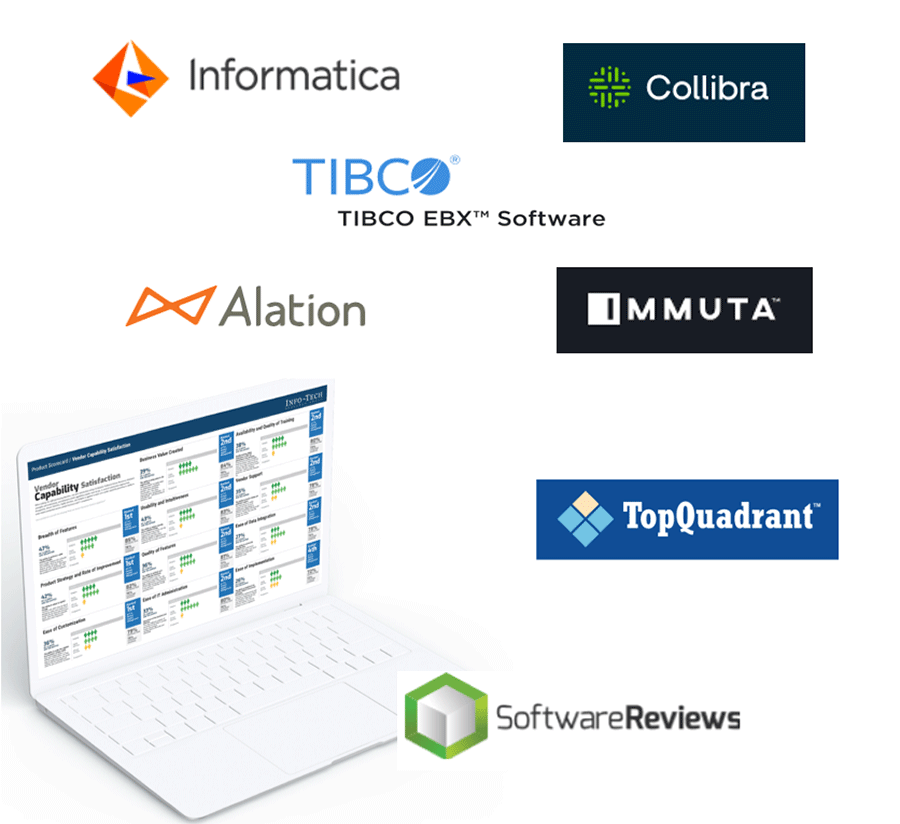
These are some of the data governance tools and technology players. Check out SoftwareReviews for help making better software decisions.
Make the data steward the catalyst for organisational change and driving data culture
The data steward must be empowered and backed politically with decision-making authority, or the role becomes stale and powerless.
Ensuring compliance can be difficult. Data stewards may experience pushback from stakeholders who must deliver on the policies, procedures, and processes that the data steward enforces.
Because the data steward must enforce data processes and liaise with so many different people and departments within the organisation, the data steward role should be their primary full-time job function – where possible.
However, in circumstances where budget doesn't allow a full-time data steward role, develop these skills within the organisation by adding data steward responsibilities to individuals who are already managing data sets for their department or line of business.
Info-Tech Tip
A stewardship role is generally more about managing the cultural change that data governance brings. This requires the steward to have exceptional interpersonal skills that will assist in building relationships across departmental boundaries and ensuring that all stakeholders within the organisation believe in the initiative, understand the anticipated outcomes, and take some level of responsibility for its success.
Changes to organisational data processes are inevitable; have a communication plan in place to manage change
Create awareness of your data governance program. Use knowledge transfer to get as many people on board as possible.
Data governance initiatives must contain a strong organisational disruption component. A clear and concise communication strategy that conveys milestones and success stories will address the various concerns that business unit stakeholders may have.
By planning for and efficiently communicating any changes that a data governance initiative may bring, many initial issues can be resolved from the outset.
Governance recommendations will require significant business change. The redesign of a substantial number of data processes affecting various business units will require an overhaul of the organisation's culture, thought processes, and procedures surrounding its data. Preparing people for change well in advance will allow them to take the necessary steps to adapt and reduce potential confrontation.
Because a data governance initiative will involve data-driven business units across the organisation, the governance team must present a compelling case for data governance to ensure acceptance of new processes, rules, guidelines, and technologies by all data producers and users.
Attempting to implement change without an effective communication plan can result in disagreements over data control and stalemates between stakeholder units. The recommendations of the governance group must reflect the needs of all stakeholders or there will be pushback.
Info-Tech Insight
Launching a data governance initiative is guaranteed to disrupt the culture of the organisation. That disruption doesn't have to be detrimental if you are prepared to manage the change proactively and effectively.
Create a common data governance vision that is consistently communicated to the organisation
A data governance program should be an enterprise-wide initiative.
To create a strong vision for data governance, there must be participation from the business and IT. A common vision will articulate the state the organisation wishes to achieve and how it will reach that state. Visioning helps to develop long-term goals and direction.
Once the vision is established, it must be effectively communicated to everyone, especially those who are involved in creating, managing, disposing, or archiving data.
The data governance program should be periodically refined. This will ensure the organisation continues to incorporate best methods and practices as the organisation grows and data needs evolve.
Info-Tech Tips
- Use information from the stakeholder interviews to derive business goals and objectives.
- Work to integrate different opinions and perspectives into the overall vision for data governance.
- Brainstorm guiding principles for data and understand the overall value to the organisation.
Develop a compelling data governance communications plan to get all departmental lines of business on board
A data governance program will impact all data-driven business units within the organisation.
A successful data governance communications plan involves making the initiative visible and promoting staff awareness. Educate the team on how data is collected, distributed, and used, what internal processes use data, and how that data is used across departmental boundaries.
By demonstrating how data governance will affect staff directly, you create a deeper level of understanding across lines of business, and ultimately, a higher level of acceptance for new processes, rules, and guidelines.
A clear and concise communications strategy will raise the profile of data governance within the organisation, and staff will understand how the program will benefit them and how they can share in the success of the initiative. This will end up providing support for the initiative across the board.
A proactive communications plan will:
- Assist in overcoming issues with data control, stalemates between stakeholder units, and staff resistance.
- Provide a formalised process for implementing new policies, rules, guidelines, and technologies, and managing organisational data.
- Detail data ownership and accountability for decision making, and identify and resolve data issues throughout the organisation.
- Encourage acceptance and support of the initiative.
Info-Tech Tip
Focus on literacy and communication: include training in the communication plan. Providing training for data users on the correct procedures for updating and verifying the accuracy of data, data quality, and standardised data policies will help validate how data governance will benefit them and the organisation.
Leverage the data governance program to communicate and promote the value of data within the organisation
The data governance program is responsible for continuously promoting the value of data to the organisation. The data governance program should seek a variety of ways to educate the organisation and data stakeholders on the benefit of data management.
Even if data policies and procedures are created, they will be highly ineffective if they are not properly communicated to the data producers and users alike.
There needs to be a communication plan that highlights how the data producer and user will be affected, what their new responsibilities are, and the value of that change.
To learn how to manage organisational change, refer to Info-Tech's Master Organisational Change Management Practices.
Understand what makes for an effective policy for data governance
It can be difficult to understand what a policy is, and what it is not. Start by identifying the differences between a policy and standards, guidelines, and procedures.

The following are key elements of a good policy:
| Heading | Descriptions |
|---|---|
| Purpose | Describes the factors or circumstances that mandate the existence of the policy. Also states the policy's basic objectives and what the policy is meant to achieve. |
| Scope | Defines to whom and to what systems this policy applies. Lists the employees required to comply or simply indicates 'all' if all must comply. Also indicates any exclusions or exceptions, i.e. those people, elements, or situations that are not covered by this policy or where special consideration may be made. |
| Definitions | Define any key terms, acronyms, or concepts that will be used in the policy. A standard glossary approach is sufficient. |
| Policy Statements | Describe the rules that comprise the policy. This typically takes the form of a series of short prescriptive and proscriptive statements. Sub-dividing this section into sub-sections may be required depending on the length or complexity of the policy. |
| Non-Compliance | Clearly describe consequences (legal and/or disciplinary) for employee non-compliance with the policy. It may be pertinent to describe the escalation process for repeated non-compliance. |
| Agreement | Confirms understanding of the policy and provides a designated space to attest to the document. |
Leverage myPolicies, Info-Tech's web-based application for managing your policies and procedures
Most organisations have problems with policy management. These include:
- Policies are absent or out of date
- Employees largely unaware of policies in effect
- Policies are unmonitored and unenforced
- Policies are in multiple locations
- Multiple versions of the same policy exist
- Policies managed inconsistently across different silos
- Policies are written poorly by untrained authors
- Inadequate policy training program
- Draft policies stall and lose momentum
- Weak policy support from senior management
Technology should be used as a means to solve these problems and effectively monitor, enforce, and communicate policies.
Product Overview
myPolicies is a web-based solution to create, distribute, and manage corporate policies, procedures, and forms. Our solution provides policy managers with the tools they need to mitigate the risk of sanctions and reduce the administrative burden of policy management. It also enables employees to find the documents relevant to them and build a culture of compliance.
Some key success factors for policy management include:
- Store policies in a central location that is well known and easy to find and access. A key way that technology can help communicate policies is by having them published on a centralised website.
- Link this repository to other policies' taxonomies of your organisation. E.g. HR policies to provide a single interface for employees to access guidance across the organisation.
- Reassess policies annually at a minimum. myPolicies can remind you to update the organisation's policies at the appropriate time.
- Make the repository searchable and easily navigable.
- myPolicies helps you do all this and more.
 myPolicies
myPolicies
Enforce data policies to promote consistency of business processes
Data policies are short statements that seek to manage the creation, acquisition, integrity, security, compliance, and quality of data. These policies vary amongst organisations, depending on your specific data needs.
- Policies describe what to do, while standards and procedures describe how to do something.
- There should be few data policies, and they should be brief and direct. Policies are living documents and should be continuously updated to respond to the organisation's data needs.
- The data policies should highlight who is responsible for the data under various scenarios and rules around how to manage it effectively.
Examples of Data Policies
Trust
- Data Cleansing and Quality Policy
- Data Entry Policy
Availability
- Acceptable Use Policy
- Data Backup Policy
Security
- Data Security Policy
- Password Policy Template
- User Authorisation, Identification, and Authentication Policy Template
- Data Protection Policy
Compliance
- Archiving Policy
- Data Classification Policy
- Data Retention Policy
Leverage data management-related policies to standardise your data management practices
Info-Tech's Data Management Policy:
This policy establishes uniform data management standards and identifies the shared responsibilities for assuring the integrity of the data and that it efficiently and effectively serves the needs of the organisation. This policy applies to all critical data and to all staff who may be creators and/or users of such data.
Info-Tech's Data Entry Policy:
The integrity and quality of data and evidence used to inform decision making is central to both the short-term and long-term health of an organisation. It is essential that required data be sourced appropriately and entered into databases and applications in an accurate and complete manner to ensure the reliability and validity of the data and decisions made based on the data.
Info-Tech's Data Provenance Policy:
Create policies to keep your data's value, such as:
- Only allow entry of data from reliable sources.
- Employees entering and accessing data must observe requirements for capturing/maintaining provenance metadata.
- Provenance metadata will be used to track the lifecycle of data from creation through to disposal.
Info-Tech's Data Integration and Virtualisation Policy:
This policy aims to assure the organisation, staff, and other interested parties that data integration, replication, and virtualisation risks are taken seriously. Staff must use the policy (and supporting guidelines) when deciding whether to integrate, replicate, or virtualise data sets.
Select the right mix of metrics to successfully supervise data policies and processes
Policies are only as good as your level of compliance. Ensure supervision controls exist to oversee adherence to policies and procedures.
Although they can be highly subjective, metrics are extremely important to data governance success.
- Establishing metrics that measure the performance of a specific process or data set will:
- Create a greater degree of ownership from data stewards and data owners.
- Help identify underperforming individuals.
- Allow the steering committee to easily communicate tailored objectives to individual data stewards and owners.
- Be cautious when establishing metrics. The wrong metrics can have negative repercussions.
- They will likely draw attention to an aspect of the process that doesn't align with the initial strategy.
- Employees will work hard and grow frustrated as their successes aren't accurately captured.
Policies are great to have from a legal perspective, but unless they are followed, they will not benefit the organisation.
- One of the most useful metrics for policies is currency. This tracks how up to date the policy is and how often employees are informed about the policy. Often, a policy will be introduced and then ignored. Policies must be continuously reviewed by management and employees.
- Some other metrics include adherence (including performance in tests for adherence) and impacts from non-adherence.
Review metrics on an ongoing basis with those data owners/stewards who are accountable, the data governance steering committee, and the executive sponsors.
Establish data standards and procedures for use across all organisational lines of business
A data governance program will impact all data-driven business units within the organisation.
- Data management procedures are the methods, techniques, and steps to accomplish a specific data objective. Creating standard data definitions should be one of the first tasks for a data governance steering committee.
- Data moves across all departmental boundaries and lines of business within the organisation. These definitions must be developed as a common set of standards that can be accepted and used enterprise wide.
- Consistent data standards and definitions will improve data flow across departmental boundaries and between lines of business.
- Ensure these standards and definitions are used uniformly throughout the organisation to maintain reliable and useful data.
Data standards and procedural guidelines will vary from company to company.
Examples include:
- Data modelling and architecture standards.
- Metadata integration and usage procedures.
- Data security standards and procedures.
- Business intelligence standards and procedures.
Info-Tech Tip
Have a fundamental data definition model for the entire business to adhere to. Those in the positions that generate and produce data must follow the common set of standards developed by the steering committee and be accountable for the creation of valid, clean data.
Changes to organisational data processes are inevitable; have a communications plan in place to manage change
Create awareness of your data governance program, using knowledge transfer to get as many people on board as possible.
By planning for and efficiently communicating any changes that a data governance initiative may bring, many initial issues can be resolved from the outset.
Governance recommendations will require significant business change. The redesign of a substantial number of data processes affecting various business units will require an overhaul of the organisation's culture, thought processes, and procedures surrounding its data. Preparing people for change well in advance will allow them to take the necessary steps to adapt and reduce potential confrontation.
Because a data governance initiative will involve data-driven business units across the organisation, the governance team must present a compelling case for data governance to ensure acceptance of new processes, rules, guidelines, and technologies by all data producers and users.
Attempting to implement change without an effective communications plan can result in disagreements over data control and stalemates between stakeholder units. The recommendations of the governance group must reflect the needs of all stakeholders or there will be pushback.
Data governance initiatives will very likely bring about a level of organisational disruption. A clear and concise communications strategy that conveys milestones and success stories will address the various concerns that business unit stakeholders may have.
Info-Tech Tip
Launching a data governance program will bring with it a level of disruption to the culture of the organisation. That disruption doesn't have to be detrimental if you are prepared to manage the change proactively and effectively.
Other Deliverables:
The list of supporting deliverables will help to kick start on some of the Data Governance initiatives
- Data Classification Policy, Standard, and Procedure
- Data Quality Policy, Standard, and Procedure
- Metadata Management Policy, Standard, and Procedure
- Data Retention Policy and Procurement
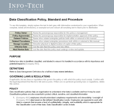
Data Classification Policy, Standard, and Procedure

Data Retention Policy and Procedure
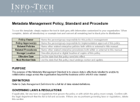
Metadata Management Policy, Standard, and Procedure
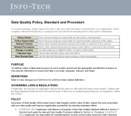
Additional Support
If you would like additional support, have our analysts guide you through other phases as part of an Info-Tech Workshop.

Contact your account representative for more information.
workshops@infotech.com 1-888-670-8889
To accelerate this project, engage your IT team in an Info-Tech workshop with an Info-Tech analyst team. Info-Tech analysts will join you and your team at your location or welcome you to Info-Tech's historic Toronto office to participate in an innovative onsite workshop.
The following are sample activities that will be conducted by Info-Tech analysts with your team:
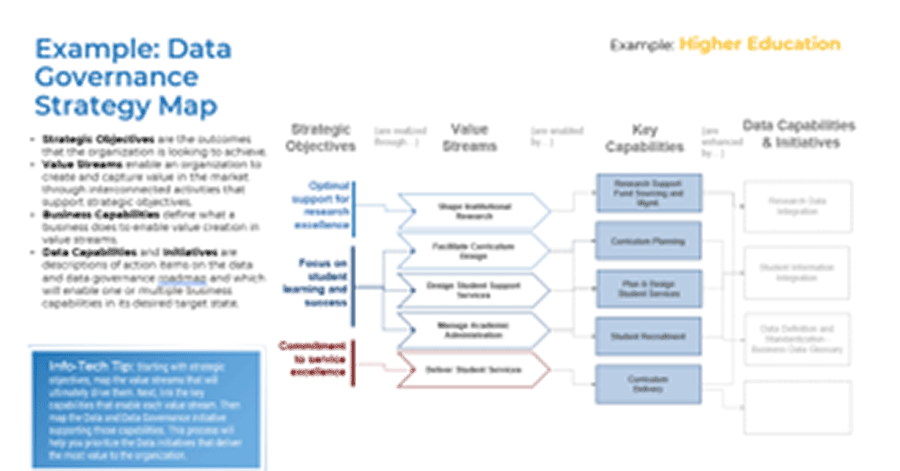
Build Your Business and User Context
Work with your core team of stakeholders to build out your data governance strategy map, aligning data governance initiatives with business capabilities, value streams, and, ultimately, your strategic priorities.
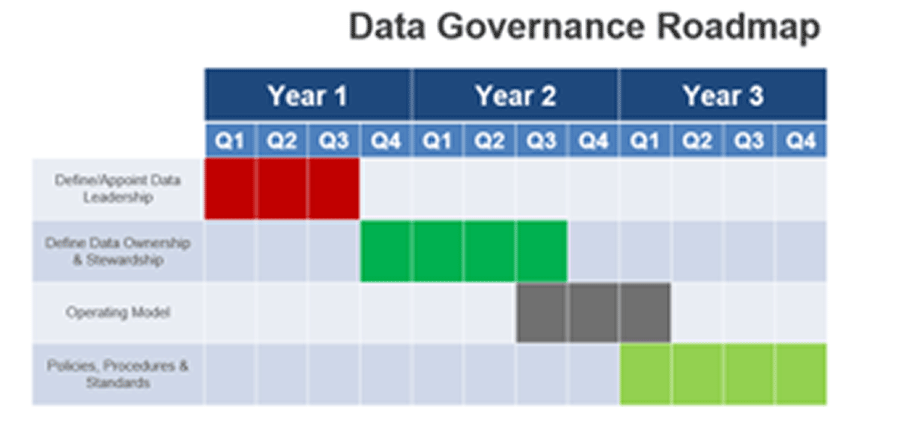
Formulate a Plan to Get to Your Target State
Develop a data governance future state roadmap and plan based on an understanding of your current data governance capabilities, your operating environment, and the driving needs of your business.
Related Info-Tech Research
Build a Robust and Comprehensive Data Strategy
Key to building and fostering a data-driven culture.
Create a Data Management Roadmap
Streamline your data management program with our simplified framework.
The First 100 Days as CDO
Be the voice of data in a time of transformation.
Research Contributors
| Name | Position | Company |
|---|---|---|
| David N. Weber | Executive Director - Planning, Research and Effectiveness | Palm Beach State College |
| Izabela Edmunds | Information Architect | Mott MacDonald |
| Andy Neill | Practice Lead, Data & Analytics | Info-Tech Research Group |
| Dirk Coetsee | Research Director, Data & Analytics | Info-Tech Research Group |
| Graham Price | Executive Advisor, Advisory Executive Services | Info-Tech Research Group |
| Igor Ikonnikov | Research Director, Data & Analytics | Info-Tech Research Group |
| Jean Bujold | Senior Workshop Delivery Director | Info-Tech Research Group |
| Rajesh Parab | Research Director, Data & Analytics | Info-Tech Research Group |
| Reddy Doddipalli | Senior Workshop Director | Info-Tech Research Group |
| Valence Howden | Principal Research Director, CIO | Info-Tech Research Group |
Bibliography
Alation. “The Alation State of Data Culture Report – Q3 2020.” Alation, 2020. Accessed 25 June 2021.
Allott, Joseph, et al. “Data: The Next Wave in Forestry Productivity.” McKinsey & Company, 27 Oct. 2020. Accessed 25 June 2021.
Bean, Randy. “Why Culture Is the Greatest Barrier to Data Success.” MIT Sloan Management Review, 30 Sept. 2020. Accessed 25 June 2021.
Brence, Thomas. “Overcoming the Operationalization Challenge With Data Governance at New York Life.” Informatica, 18 March 2020. Accessed 25 June 2021.
Bullmore, Simon, and Stuart Coleman. “ODI Inside Business – A Checklist for Leaders.” Open Data Institute, 19 Oct. 2020. Accessed 25 June 2021.
Canadian Institute for Health Information. “Developing and Implementing Accurate National Standards for Canadian Health Care Information.” Canadian Institute for Health Information. Accessed 25 June 2021.
Carruthers, Caroline, and Peter Jackson. “The Secret Ingredients of the Successful CDO.” IRM UK Connects, 23 Feb. 2017.
Dashboards. “Useful KPIs for Healthy Hospital Quality Management.” Dashboards. Accessed 25 June 2021.
Dashboards. “Why (and How) You Should Improve Data Literacy in Your Organization Today.” Dashboards. Accessed 25 June 2021.
Datapine. “Healthcare Key Performance Indicators and Metrics.” Datapine. Accessed 25 June 2021.
Datapine. “KPI Examples & Templates: Measure what matters the most and really impacts your success.” Datapine. Accessed 25 June 2021.
Diaz, Alejandro, et al. “Why Data Culture Matters.” McKinsey Quarterly, Sept. 2018. Accessed 25 June 2021.
Everett, Dan. “Chief Data Officer (CDO): One Job, Four Roles.” Informatica, 9 Sept. 2020. Accessed 25 June 2021.
Experian. “10 Signs You Are Sitting On A Pile Of Data Debt.” Experian. Accessed 25 June 2021.
Fregoni, Silvia. “New Research Reveals Why Some Business Leaders Still Ignore the Data.” Silicon Angle, 1 Oct. 2020
Informatica. Holistic Data Governance: A Framework for Competitive Advantage. Informatica, 2017. Accessed 25 June 2021.
Knight, Michelle. “What Is a Data Catalog?” Dataversity, 28 Dec. 2017. Web.
Lim, Jason. “Alation 2020.3: Getting Business Users in the Game.” Alation, 2020. Accessed 25 June 2021.
McDonagh, Mariann. “Automating Data Governance.” Erwin, 29 Oct. 2020. Accessed 25 June 2021.
NewVantage Partners. Data-Driven Business Transformation: Connecting Data/AI Investment to Business Outcomes. NewVantage Partners, 2020. Accessed 25 June 2021.
Olavsrud, Thor. “What Is Data Governance? A Best Practices Framework For Managing Data Assets.” CIO.com, 18 March 2021. Accessed 25 June 2021.
Open Data Institute. “Introduction to Data Ethics and the Data Ethics Canvas.” Open Data Institute, 2020. Accessed 25 June 2021.
Open Data Institute. “The UK National Data Strategy 2020: Doing Data Ethically.” Open Data Institute, 17 Nov. 2020. Accessed 25 June 2021.
Open Data Institute. “What Is the Data Ethics Canvas?” Open Data Institute, 3 July 2019. Accessed 25 June 2021.
Pathak, Rahul. “Becoming a Data-Driven Enterprise: Meeting the Challenges, Changing the Culture.” MIT Sloan Management Review, 28 Sept. 2020. Accessed 25 June 2021.
Petzold, Bryan, et al. “Designing Data Governance That Delivers Value.” McKinsey & Company, 26 June 2020. Accessed 25 June 2021.
Redman, Thomas, et al. “Only 3% of Companies’ Data Meets Basic Quality Standards.” Harvard Business Review. 11 Sept 2017.
Smaje, Kate. “How Six Companies Are Using Technology and Data To Transform Themselves.” McKinsey & Company, 12 Aug. 2020. Accessed 25 June 2021.
Talend. “The Definitive Guide to Data Governance.” Talend. Accessed 25 June 2021.
“The Powerfully Simple Modern Data Catalog.” Atlan, 2021. Web.
U.S. Geological Survey. “Data Management: Data Standards.” U.S. Geological Survey. Accessed 25 June 2021.
Waller, David. “10 Steps to Creating a Data-Driven Culture.” Harvard Business Review, 6 Feb. 2020. Accessed 25 June 2021.
“What Is the Difference Between A Business Glossary, A Data Dictionary, and A Data Catalog, and How Do They Play A Role In Modern Data Management?” Analytics8, 23 June 2021. Web.
Wikipedia. “RFM (Market Research).” Wikipedia. Accessed 25 June 2021.
Windheuser, Christoph, and Nina Wainwright. “Data in a Modern Digital Business.” Thoughtworks, 12 May 2020. Accessed 25 June 2021.
Wright, Tom. “Digital Marketing KPIs - The 12 Key Metrics You Should Be Tracking.” Cascade, 3 March 2021. Accessed 25 June 2021.
